Better Than Any Man by Libertad!
Foreword
Original SA post It Came From Drive-Thru RPG: Better Than Any Man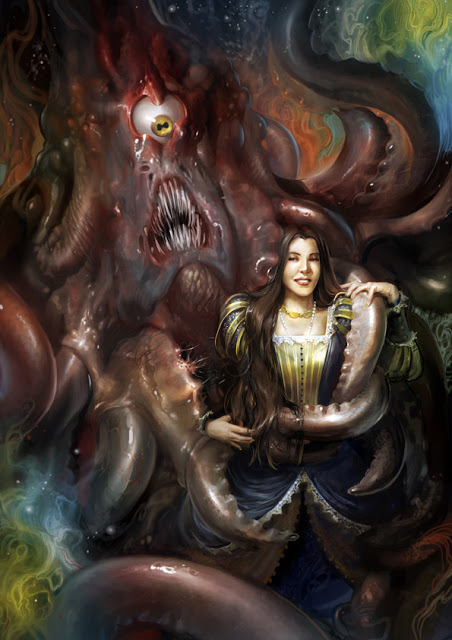
Foreward
Lamentations of the Flame Princess is a retroclone, a rule-set based off of an older Edition of Dungeons & Dragons. Specifically, Basic D&D around the Basic/Expert era. It’s most famous for its artwork and its nightmarish chthonic horror vibe. Blasty spells are mostly absent, with existing spells redesigned and altered to reflect a more “things man was not meant to know or toy with” feel. The Fighter is the only class whose attack bonus increases in level. Alignment is divided into Law, Neutrality, and Chaos, and does not reflect morality so much as what incomprehensible cosmic forces are watching over you. The implied setting is very Dark Ages; almost no spellcasters exist, the majority of the world are 0 level humans (equivalent to 1st-level Commoners in 3.X parlance), and what monsters exist are out in the barren wilderness, hardly seen except by desperate adventurers and insane cultists.
Lamentations of the Flame Princess is free, in case you feel like checking it out yourself.
And Better Than Any Man is free too, on a Pay What You Want basis.
Author’s Notes
quote:
Welcome to LotFP’s Free RPG Day adventure! It isn’t what it is supposed to be.
We were told “Include quickstarter rules!” We were advised to create a short introductory/teaser adventure. We were warned to make it suitable for all audiences.
We didn’t do that. You know why?
0.
That is the amount of fucks we give about what we’re supposed to do.
What we did do is create an expansive, epic adventure bigger than any we’ve made up to this point. We made it layered and complicated and figured that as a tabletop role-player, you’re an intelligent, creative adult who is capable of working things out. We didn’t avoid “controversial” content because bowdlerizing our content would be dishonest, lame as hell, not to mention it would misrepresent the rest of the LotFP product line. Basically, we wanted to make this the best and most awesome thing we can possible make with no boundaries. This is role-playing. You can do anything! And so can we.
Because that’s what we give a fuck about. And for us, Free RPG Day is all about finding the sorts of people who love the same things we do. So here’s a free adventure. If you appreciate it, welcome aboard. If you don’t, well, sucks to be you. The rules will probably look familiar to you in an old school kind of way, but if you look at the details, you’ll find it produces more chaotic, more horror-oriented play than the standard epic
fantasy fare these sorts of games usually produce. We didn’t try to do “like this other game but better,” we did “like this other game but different.”
If you have questions about this adventure or about LotFP in general, we have a message board at http://www.lotfp.com as well as Facebook and Google Plus pages where current LotFP fans can help you out. You can also email LotFP HQ directly at lotfp@
lotfp.com.
So enjoy and remember to read Grant Morrison’s Doom Patrol comics, the Oglaf web comic, and the Perry Bible Fellowship comic strip; listen to Candlemass, Reverend Bizarre, and early 90s Swedish and Tampa Bay death metal; watch Hammer Horror, 70s and 80s Dario Argento, Dan O’Bannon, and 70s and 80s John Carpenter movies; read stories by Clark Ashton Smith, Clive Barker, Thomas Ligotti, Carlton Mellick III, Ryan Harding, and RE Howard (Solomon Kane and Bran Mak Morn; leave the famous barbarian alone for now…), and yeah, Loveydoveycraft.
[right]James Edward Raggi IV
March 5, 2013
Helsinki, Finland[/right]
As you can tell from his notes, Raggi’s publications tend to go for an “edgy” vibe, and that’s exactly what he wants in an RPG. I don’t really think he’s sticking it to anybody or taking many risks by writing a free 96 page adventure, considering that his work is known for pushing the envelope and that’s part of why his fanbase loves him. If anything, it made his product more noticeable amid the competing introductory fantasy adventures. But it does tell us exactly where his inspirations lie and gives us a feel for the kind of work he does.
The Adventure Itself
Better Than Any Man is James Raggi’s magnum opus of adventures. For the upcoming Free RPG Day, he wrote up a 96 page adventure for parties levels 1-4 to be printed and sent it to stores (and to eventually be uploaded for free to Drive-Thru RPG). It serves as an introduction of sorts to the LotFP franchise, and can be used with other old-school games (there’s a sort of overlap in rules of some popular old-school retroclones).
It’s set in real-world 1600s Holy Roman Empire (Germany, to be exact) during the Thirty Years War. Basically the Swedish army is invading the Empire, intent on slaughtering everyone they come across. Tens of thousands of people are fleeing south, giving rise to refugee colonies and predatory bandits. A group of witches (the genuine kind) has taken control of the town of Karlstadt, and the Prince-Bishop of Würzburg (the biggest city in the region) is shoring up his army instead of trying to repel the invaders directly. The adventure takes place in this northern German region, and the chaos and desperation makes it seem like the world is falling apart. And amidst it all, darker inhuman forces move unseen
Raggi deliberately chose to base this adventure in real-world Europe because he views the dynamics of real-world religions and history to be more relatable to the players, and that they’ll take the game more seriously if it involves Lutherans and Catholics and Germans and Swedes as opposed to fictional D&D deities and elves and dwarves.
quote:
If you or your players are uncomfortable with this, that is the entire point. This game does not deliver “fun” by encouraging players to feel heroic and successful, it encourages “fun” by allowing the player characters to exercise power of the world through their choices, and having those choices be meaningful due to the consequences that will be suffered by those tagged with familiar, and perhaps relatable, labels. If it all goes horrible and everyone dies painfully and the players wreck the world, then so what? It’s a game. Nobody got hurt. Try to do better next time.
Thing is, many players might not be attached to the 30 Years War and its cultural aftermath. I don’t know how strong of a subject it is in Europe, but I don’t think that it would resonate with my own group or many US gamers. So while I can see where Raggi was going, I don’t think it’s a guaranteed success. As for the religious angle, the war is more of a backdrop, with the focus on the Seven witches of Karlstadt the stuff their followers are up to in the region.
Personal choice is a big part of the adventure. PCs are by no means required to stick around, or even benefit from acting “good-aligned.” They’re pretty much free to act as how things would benefit them.
Also, world-wrecking options are a rather popular staple in LotFP adventures, and it’s no different here.
quote:
This adventure also delivers “fun” in the same manner as a horror movie that damn near makes you piss yourself in fear right there in the theater. Or at least makes you nervously chuckle since you feel guilty about enjoying horrible things on the screen. Instead of a more-or-less religious war setting, this sort of fun could just as easily have been delivered in the form of an adventure set in the New World with slavery and subjugated natives all over the place, so quiet down, or that’s what you get for Free RPG Day next year.
Player comfort is rather important, and while some potentially problematic subjects can be used for good entertainment, it’s often hard to see where the line crossed unless you talk with the group beforehand. Especially so for tabletop RPGs, which provide a very immersive and intimate setting with a group of friends, and even more so with "mature" subject matter.
Adventure Background, or why things are going down
The adventure takes place in lower Franconia, a region in northern Germany, centered around the town of Karlstadt. It’s October 1631, 13 years into the Thirty Years War. The battle began as a civil war within the Holy Roman Empire between Protestants and Catholics, but mushroomed into an international fracas of just about every major European power engaging in some way or other. Protestants and Catholics are killing each other in the tens of thousands, destroying entire cities. The Swedish Army (which is Lutheran), commanded by King Adolphus, has invaded the northern Empire and is pretty much an unstoppable juggernaut. Some Protestants in the Empire view him as a savior, others a butcher for the army’s complete lack of mercy. The Army is on the march to Würzburg (the major city in the region), with Karlstadt right in the middle of the warpath.
Complicating matters is that ten days ago Karlstadt was taken over by a group of witches known as the Seven. Each of them for their own reasons are disgusted with the status quo and religious conflict, and laid down a new law: “no more war.” They closed down all the churches and disarmed the populace in an attempt to bring peace. Additionally they formed the Citizen’s Peace Patrol, or Bürgerfriedensmiliz. Trained in the use of ropes and nets, they’re patrolling the countryside and disarming any small groups bearing arms and armor. Although most of their order believe in the Seven’s ability to quell the conflict, there’s a secret inner circle among them dedicated to the worship of the Insect God. This fell entity seeks to bring down humanity and have his spawn reclaim Earth as the dominant species.
News of the witches’ takeover reached King Adolphus, and Karlstadt has become their primary target; they view diabolic sorcery as far worse than Christian heresy, and the rulers of Würzburg do not seek to intervene as this will delay the Swedish Army. Unfortunately for the Empire, Adolphus believes that their government is complicit in the witches’ existence, and holds them equally guilty. Many refugees believe that the witches’ magic might be enough to protect them from the foreign invaders, and so quite a lot of them are willing to take their chances by trying to get into Karlstadt.
Over the course of eight days from the start of the adventure, the 30,000 Swedish Army will sweep through the region. They’ll first appear on the fifth day and then direct their warpath to Würzburg. Unless the PCs take action to change things, the army will way waste to everyone in the towns in their path (Karlstadt included) by day 8, and then spend the next 3 days laying siege to the dungeons in the region in a failed attempt to eradicate sorcery. One of them, the Infinite Tower, is blown apart with gunpowder and spills the blood of its millions of inhabitants into the river. Their brutality will make King Adolphus go down in the history books as a bloodthirsty maniac, turning even many Protestants against him. The role of sorcery in the war will only exacerbate existing witch hunts throughout northern Europe, eventually targeting scholars and scribes for “suspected witchcraft.”
Society is falling apart. Entire villages and farms are abandoned, the two large towns are overcrowded with refugees, witch-burnings are at an all-time high, and it seems like nothing can stop the Swedes. The PCs, allegedly here to plunder and benefit from the chaos, are just wandering through the region as all this happens. They can’t save everyone, and the adventure does not give any hard and fast goals or happy endings, but it does provide suggestions. For one, the Swedish Army cannot be thwarted in conventional combat (there’s just too many of them), and the existing forces cannot repel them. Assassinating King Adolphus will not stop the Army’s onslaught.
Saving the people of Würzburg will involve convincing the army that the Holy Roman Empire does not approve of the Seven’s rule (which is true, but the Swedes won’t believe it unless they see the Empire’s army assaulting the city, or are given the Seven’s severed heads by Würzburg’s Prince-Bishop); saving Karlstadt will require convincing the Swedes that the witches rule against the will of the people, which is not possible given that so many refugees want to enter the city.
quote:
The adventure assumes that the player characters are outsiders, passing through the area for their own reasons. The Referee should know his players and their characters better than any adventure writer ever could. We present the situation and the environment; it is up to you to provide the enticement for the characters to get involved. (Although if they require more than “Hey, there’s some interesting adventure stuff here!” then your players are lame.)
The Referee can start the adventure by rolling 1d8 and, assuming due north is 1 and going clockwise, use that number to determine the side of the map where the player characters begin in the morning of Day 1 (October 8th, 1631).
The Referee needs to make sure that these two ideas are strongly communicated by the first people that the player characters talk to: “Karlstadt was been taken over by sorcerers about ten days ago!” and “The Swedish army is coming! They’re invincible! They’re about a week’s march away!” If they do not want to talk to anyone, well, they must be happy to aimlessly wander around the countryside. Which can still result in fun adventures if you bring random encounters to life.
This adventure does not make presumption upon the PCs being heroes or having a linear goal. It’s a rather open sandbox environment, where the PCs are faced with a few primary conflicts, but are not given a clear means of what to do or where to go. The lack of linearity and “here’s what you’re doing” plot hooks provide much in the way of freedom, but requires additional work on the part of both players and Dungeon Master for the PCs to get involved (and choose to stay, if things start getting hopeless and it looks like not bothering at all is the best way to go).
I can already think of some adventure hooks:
1.) The PCs are witch-hunters and dispatched to investigate the Seven.
2.) The government of Wurzburg has put a bounty of 1,000 silver pieces per head of the Seven (10,000 for all seven; this is present within the adventure itself). The PCs plan on killing them.
3.) The PCs heard rumors of the dungeons in the area, and are ready to go treasure-hunting.
4.) The PCs are spies for either the Empire or the Swedes, tasked with gathering intelligence about the situation in Karlstadt/the invading army/the Prince-Bishop of Wurzburg.
5.) The PCs have sentimental ties to the region, and seek to find an end to the carnage.
Thoughts so far: Sorry it took so long to just set things up, but given the sandbox nature of Better Than Any Man I had to throw up these major plot points so you have a sense of the overall situation. Overall I like this set-up; it’s unconventional for being set in Renaissance Europe, but it’s definitely an interesting and engaging plot.
Next time, we learn what’s going on with the Seven!
The Seven
Original SA post
Better Than Any Man: The Seven
Basically the Seven are a group of female spellcasters who previously never knew each other, but were caught up in the witch-hunting frenzy sweeping the Empire. They had all lost their families to the War, and thus had nobody to stand for them. Gabriele Baur, a witch whose husband was a government official, obtained a list of the accused. Once she determined that the seven accused were the real deal, she convinced them to take part in a magical ritual which would allow them to take control of Karlstadt and make things right. At the end of the spell's casting Baur died, and the townsfolk recognized the seven witches as the true and rightful rulers of Karlstadt.
Unfortunately the spell came with complications. None of the witches knew each other or have good leadership skills, and they couldn't delegate power as the magic prevented the people from seeing anybody else as legitimate. Additionally, the Seven were viewed as equally valid, meaning that only unanimous consensus would be taken as law.
The few things the Seven agreed upon were: that they were tired of war, and so banned all use of weapons and tools intended for violent purposes (farming equipment and tools which could conceivably be used as weapons don't count); they hated how religious zealotry fueled the witch hunts and sectarian violence, so they made religion a private affair and all faiths would be treated equally before the law; conditions of birth, such as noble titles, nationalities, and gender, did not afford any special privilege and all are thus equal under the law (they're all women, most are not nobles, and some have foreign ancestry); and the Seven were exempt from all laws (the Watcher is devoutly religious, while the Defiler is too paranoid to disarm herself).
Naturally, the citizens are frightened and confused at this new state of affairs and what it would spell for society. Existing lawmakers and enforcers lost their jobs, and houses of worship were converted into other functions. Only the Joy and the Provider have any interest in settling disputes and governing, but they frequently disagree on affairs. The only thing keeping hope alive is that the witches' blasphemous magic might be enough to protect them from the Swedish Army.
Too bad all but one of the Seven are 1st level magic-users with Read Magic and a single other unique spell. They're all very aware that, even combined, their magic won't be enough to fend them off; they guard this information to prevent panic.
Each of them also has a unique otherworldly entity under their control. None of them know the creatures' origins, they were not deliberately summoned, and they possess no means of communication. Their true origins are left a mystery for the Dungeon Master to fill in (Raggis chastises you in the text if you tie their origin to the Insect God: "you're being lazy"). They're really powerful, game stat-wise. Two of them have 10 hit dice, one 9, two 6, one 3 (the Defiler's), and only the Defender's has no game stats. Three have an Armor Class of 16 or better, one cannot be hit (the Joy's), and the lowest is 12 (the Defiler's). Their attacks are not strong in terms of hit point damage, but some of their special attacks are quite debilitating. 1st-level PCs won't be able to handle most of the monsters (except for maybe the Defiler's), and trying to attack the Seven will bring their wrath. Assassinating or otherwise harming the Seven will be really hard to do in this adventure.
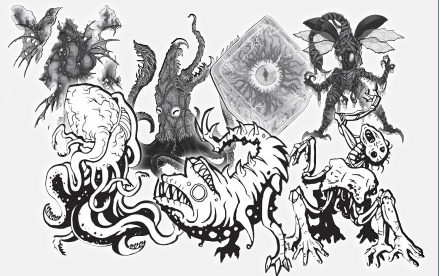
The Defender: She's the woman with a fancy full-length gown and curls in her hair. Her name is Griselda Uhrlitz. She's spoiled, always wanted to be someone famous, and took up the practice of magic upon her husband's death. She puts up a tough exterior ("We're invincible! Nobody will cross us!") but in reality this bravado only comes from the backing of the other six and her loyal creature protecting her.
Her unique spell is "Be Impressive," which cleans the caster and makes their clothes look awesome. It grants a +1 bonus per caster level to the next Loyalty and reaction roll (old school equivalent to Charisma-based skills).
The Defender's creature is the tentacle snake thing with a brain at the end. It takes an aspect of a single character (Ability Score, Armor Class, Hit Points, Movement Rate) within 100 feet of the Defender who has the highest value, and grants it to her. The character has an effective 0 in that score (or reduced to 1d6 hit points), and there is no defense of Saving Throw to resist it. And it steals prepared magic-user spells and special abilities, too! The lost abilities are returned once they exit the radius. It otherwise has no listed game stats.
It's not said in the text, but given that Karlstadt is overcrowded with refugees, people will be dropping incapacitated around the Defender wherever she walks. It might not be immediately noticeable (there's a lot of sick and dying people), but it's definitely creepy and really illustrates that the Seven aren't gaining their powers from a benign source.
The Defiler: Her picture is the most bad-ass of the bunch, so I'm putting a higher-resolution version right here:
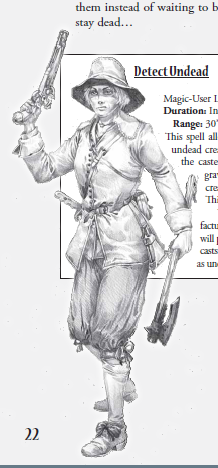
I will give it to Raggi; while his art might be overly sensationalist in the gore department, all of his female adventurers are dressed for the part and look like they can kick your ass. Nary a boob-plate or pin-up pose in sight!
Emma Gäbges' children and husband died, and she believes that their ghosts haunt them. She tried to pray to God, tried to have priests exorcise her residence, even tried folk magic from village wise women, but their voices would not go away. When she learned magic on her own, she became an undead hunter; only problem is, she's overly paranoid and spends most of the day digging up graves thoroughly ravaging corpses so they won't rise up.
Her unique spell is Detect Undead, and can point out their presence if they're within 30 feet. Unfortunately she is delusional, so 1 out of 10 times she'll detect a living creature as the walking dead.
Her servitor creature is the two-mouthed fish thing. It can swallow opponents into an extradimensional space (like Gluttony from Fullmetal Alchemist), where an identical creature lurks. This creature also has an extradimensional stomach, which also has an identical creature, which also has an extradimensional stomach... and so on and so forth. Each creature has infinite stomachs and spaces, meaning that characters swallowed by the same creature are in different spaces (and thus "branch out").
The Joy: Ludmilla Röder intended to convert a house in Karlstadt into a refuge for those fleeing from religious persecution, but it turned into a den of vice. Thanks to societal breakdown, the openly supernatural rule of the Seven, and the abolishment of organized religion, many townsfolk feel like the end of the world is coming and so indulge in sinful pleasures. And the Joy is more than happy to participate. The only hard and fast rules are no bestiality (so she turned over her servitor creature to the Watcher) and no pedophilia, although the text says that 17th century society "has different standards as to what 'too young' is." Uh, this last part might be better off not mentioned: the age of consent laws historically were really fucking low. Sorry, but I prefer adults-only sex parties in my fictional elf games.
Her unique spell is Enhance Sensation, which doubles hit point loss and negative effects (loss of sleep, pain, etc), and can case positive sensations to become addictive (or an effective charm spell in the case of sex).
The Joy's position makes her an expert information broker. She can tell the PCs about the Seven, the Citizen's Peace Patrol, outlying towns and the region's dungeons (Goblin Hill, the Infinite Tower, the Mound, the Abandoned Farmhouse). But she's not interested in money.
quote:
Ludmilla knows a great deal and will tell what she knows, but there are conditions. The list here shows the information that she knows about the key players in the region and their locations, and the conditions that have to be met for her to talk. “If you want me to give you something, you have to give me something. And I’ve already got a lot. I hope you can handle it…” This will serve as warning to characters and players alike that things are about to get messy, and to back off if that makes them… uncomfortable. If a condition is set out and the deal then declined, The Joy will give no more information on any subject until the established condition is fulfilled.
Several of the conditions involve a random person chosen by Ludmilla. The Referee should randomly determine this person’s gender and physical qualities—it would be hardly fair to just declare the person in question to be the most unattractive or inappropriate match for the character in question. Fun, but not fair.
There is also mention of the, ah, quality of certain acts to be performed. The Referee will have to come up with his own way of determining if a character’s performance is good enough. LotFP purposefully lacks the mechanics for that. It is not FATAL, you pervert.
She knows the real names, home addresses, and the powers of all The Seven’s servitor creatures and will divulge that information in addition to that listed for the sorceress in question if the conditions are met… Though she will only do so if is asked about those details specifically.
Yup, if you want answers, you've got to indulge Ludmilla's perversions. Most of them involve doing the nasty with some nameless NPC(s) in the bar with some condition, but even a few of the non-sexual ones sound like she's getting off to it (“Whew the bar’s a mess over there. Clean it up. With your tongue.”). There's a separate task for each of the most common subjects for questions (of which there are 17), and a few answers aren't really useful (The Infinite Tower: It's bigger on the inside"). However, several answers are very useful and can give the PCs an edge in future endeavors (like secret passages in the town and Goblin Hill).
Not really a fan; it's hard to have this in an adventure without it either devolving into absurdity, having the PCs refuse (and thus cut out from information), or players saying that their characters are great in bed to satisfy the Joy's standards. Some of the non-sexual tasks (liking shaving the head of one of the Seven) could serve as a good basis for less "adult" alternatives if your group won't like it as-is.
The Mother: Ulrike Lamprecht is the mastermind behind the group. She is a 3rd-level Magic User who taught Bauer the spell which would make the Seven leaders of Karlstadt, knows of the tomb of the Insect God under the region, and created the Citizen's Peace Patrol to act as a front for a cult dedicated to the entity. She has 6 spells in addition to Read Magic and her unique spell, which is Speak With Insects (which does exactly that).
Her servitor creature is that deformed humanoid on the right-hand side with arms and legs as hands. When it attacks opponents it can removed their limbs and add it to its own, or add one of its own to a target. In the latter case, the limb is useless for several weeks and interferes with tasks as it randomly thrashes about.
I don't have strong preferences one way or the other for this one. Her backstory, spell, and creature are not exceptional in any way, beyond being the highest-level of the Seven.
The Provider: Jutte Beckman is a charitable and goodly woman who converted the town square into a food distribution network, and acts as a mediator for the town's problems. She also writes letters to distant towns and relies upon merchants to bring food and water into the city.
Her unique spell can create food, a days' worth of meals for 10 people per casting. If she learns of any new spellcasters in town, she'll ask for their aid and teach them the spell. Her servitor creature is a ten foot tall squid-like creature, which can cast any Magic-User spell used on it once a day. Said spell is not used up by the Magic-User in the attempt, meaning that Jutte has been using this trick ten times a day.
Unfortunately, unbeknownst to her or others, the food created has no nutritional value, and it dispels the pangs of hunter. People are still starving, though, including the Provider.
The Provider is a good addition. Having a well-adjusted and normal woman among the Seven makes for some interesting role-play opportunities and adds some dimension to an overall nefarious group.
The Reminder: Hedwig Meinecke always tried to be perfect, especially when it came to being a wife and mother. She punished herself for "failing" when she became infertile and her children died, and she obsessively studied magic in an attempt to improve her shortcomings. She discovered a spell written by her mother, Generation Gap, which allows the caster to imprint his own memories and spellcasting potential in his or her biological children. It can also be cast on a pregnant women, who must Save versus Magic or have that child be genetically identical to the caster. It's possible for said child to have the caster's memory, effectively making them "born again."
The Reminder is writing spellbooks with Read Magic to teach to as many people as possible, in the hopes that she can finally have a family with her spell. A small team of mages-to-be helps her with scribe duties.
Her servitor creature is that figure in the upper-right corner with insect wings on its head and wrapped in bandages. It's multiple natural attacks can randomize a character's ability score, experience total, swap a score with somebody else nearby, etc.
I really like the Reminder; she's my second-favorite behind the Defiler. Her goals have potential to go beyond this adventure, such as a villain intent on starting a new family, or a recurring foe who awakes years later for vengeance.
The Watcher: Ingeborg Stoltz is deeply religious, but believes that magic is not inherently evil. She's appointed herself as the town guardian and oversees passage through the town's sole remaining unblocked gate. Her unique spell is Detect Weapons, which informs her of hidden weapons and where they're located within line of sight. She's against any sort of negotiation or compromise with Würzburg or the Swedes.
Her servitor creature is the eye within the cube. It can read the memories of structures and inanimate objects and fly, making it well-suited to investigative work. Its body radiates electricity and can immobilize with its tendrils.
She also controls the Joy's servitor creature, which is the bat-winged thing in the upper left corner. It is incorporeal and has a 100 foot ranged attack which can grow cancerous tumors on a living subject. The tumors have eyes, which the creature can see through, and it deals deals hit point damage via poison over the period of weeks. If the cumulative damage over time exceeds total hit points, the tumor takes control of their body permanently (effective PC death).
The Maker: Gabriele Bauer is now dead. Her unique spell is called A Spell to Grant One's Heart's Desire. The caster must willingly commit suicide at the end of the spell's casting, and everyone within 30 feet has their wish granted provided that they can all immediately agree upon it. There must be at least 4 people present, and must be a simple clear idea (no using out-of-character game mechanics or conditions and clauses), or the spell does not work.
This spell is 1st level like all the others, and it has potential to be stupidly overpowered. Keep that in mind if your PCs find her spellbook (which is in the Bürgerfriedensmiliz headquarters in the Mother's room).
Thoughts so far: The Seven are all interesting characters who can provide plenty of adventure fodder. I like the offbeat and creative abilities of the monsters and the witches' signature spells.
Next time, countryside encounters!
Countryside Encounters
Original SA postRangpur posted:
It is, but I've read this adventure and I am at a loss as to how you accomplish anything meaningful. Not even heroic, mind; meaningful, either to the players or their characters. The way it's written seems designed to frustrate any attempt to make a profit or any control over the course of events. Raggi reminds me of the kind of GM who claims he's against hand-holding or railroading his players then throws up tedious and arbitrary roadblocks whenever they try to accomplish something outside his narrow definition of what's 'realistic for the setting.'
Credit where it's due, I do like the Seven's monsters/pets. They're weird, dangerous and otherworldly without turning them into big stompy city wreckers the way D&D threat levels seem to trend. But man that smarmy little parting shot about inventing your own reason for their existence is just a perfect goddamn snapshot of his attitude.
There are several things I take issue with in this adventure which I address later, including the extreme randomness of encounter size and lethality and the preponderance of NPCs and monsters way too strong for 1st-4th level PCs.
Better Than Any Man: Countryside Encounters
There are 30 possible random encounters the PCs can come upon during their travels in Franconia. It is a 1 in 6 chance, rolled twice a day. Raggi recommends generating an automatic encounter the first time the party arrives at a new settlement. In keeping with the RPG, almost all of the encounters involve humans and mundane animals, with the few supernatural entities unique monsters. Most of the encounters are thematic and lend themselves to growing sense of desperation. Starving orphan children wandering the countryside; looters combing through abandoned homes and villages; a family of Jews traveling to Karlstadt for its liberating laws (in this era, Jews have almost no rights); an innocent woman on the run from witch-hunters; stuff like that. Instead of being truly random, the encounters add to the adventure in some way and frame an overall picture of desperation and societal decay.
Just like many old school adventures, the number of combatants (and the Hit Die of some monsters) is randomly rolled. A high roll can really screw over the party by putting them against overwhelming odds or super-powerful monsters; this is intentional, as LotFP puts emphasis on a dangerous world where the PCs should err on the side of caution before entering into battles.
I'll list a few of the more interesting ones:
A Dark Cult: A small group of people heard about the Seven, and seek to learn magic on their own to get some power. They're performing a ritual, which might be either harmless, or a prayer to a dark entity which will be answered and may or may not involved animal or human sacrifice.
Bürgerfriedensmiliz:
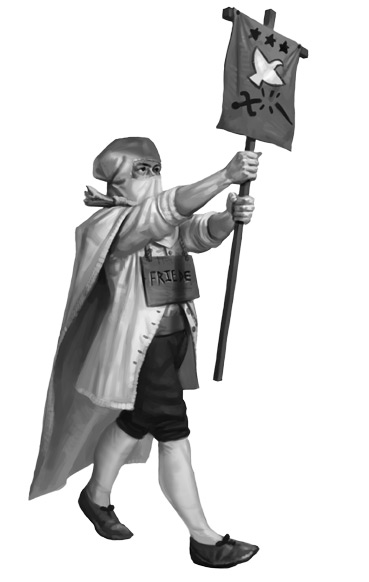
A patrol of 1d6+6 men, women, and children patrol the area, armed with lassos and mancatchers. They go around saving innocents to take back to Karlstadt (innocents are unarmed and unarmored people) and convincing armed people to give up their warlike ways, including throwing down their arms and armor. Those who refuse are asked again, and if they persist the milizionäre try to bind and subdue them. Captured characters are taken to the "re-education facility" in Goblin Hill.
Most milizionäre are genuinely well-intentioned people, and know nothing of the cult of the Insect God.
Hostile milizionäres are a separate encounter; they're part of the inner cult of the Insect God and looking for people to kidnap to take to their base. They're armed, but won't attack in the presence of other witnesses. There are as many as 3d6.
Glass Tiger: This monster is the creation of the necromancer Schwartz. An animal construct, it hunts the region for people to kill and take back to its master. It has 5 hit dice, double the normal movement speed of a human, surprises parties on a 4 in 6 chance, and has an Armor (basically Armor Class) of 15 against blunt weapons, but 20 against edged and missile weapons. Its high Armor, Hit Die, and surprise attack and speed can easily result in a TPK against low-level adventurers.
Improvisational Inquisition: Caught up in the hysteria of witch-hunting nationalist fervor, a patrol of Catholic villagers (3d6 of them) are lead by a violent priest intent on cleansing the area of Lutherans, foreigners, witches, and (if they're aware) monsters. PCs who can't or won't prove their allegiance to the Empire and the Pope will be attacked.
The Insane Farmer: Magnus Persson, a Swedish deserter, is hiding out in a farmstead. He killed the family and scattered pieces of their corpses into the fields (he believes the plants will grow with blood). The murders took place in the house, so it smells of death. He won't try attacking the PCs unless they're 2 or less, or they find out his secret.
Invisible Insects: The Insect God's children are coming out into the surface world. Quite a few of them are entirely invisible, and they've afflicted a poor man who's clawing at himself. The man runs up to the PCs to grab their bladed weapons, and if not stopped he'll claw at and cut himself until he dies. Any PC touched is infested with the invisible insects, who crawl and bite all over for days on end (or after several hours of bathing and getting rid of infected equipment), impeding sleep, concentration, movement, and to-hit rolls.
The accompanying image is a naked man, his pants in tatters, scratching himself as he bleeds all over, including from his penis. Classic LotFP artwork.
The Mastermind: Archibald Kohler is the Empire's most successful crime lord. His contacts in the region informed him of something valuable (such as one of the unique treasures and magic items in the dungeons), and he has a well-armed group of henchman in tow. He's a 7th-level Specialist (Rogue equivalent) with a cursed arm of gold (worth 10,000 silver pieces). Accompanying him are a woman posing as the Countess Bathory (0 level human), the Brute (a 4th-level Fighter and cannibal), 3 "head men" (henchmen dressed as highway robbers) all of 3rd level in Fighter or Specialist, 3 handlers (mercenaries hired by the fake Bathory), 10 dogs, 2d6 relatively harmless servants. Obviously they're more than a match for the PCs; their primary goal is to gather information, and won't attack unless provoked or the PCs have the object they're looking for.
Possession: one of the Insect God's children, the size of a fly, will fly up to one of the PCs and attempt to burrow into his/her flesh to lay eggs. If undetected and successful, the eggs will eventually hatch over a period of hours, and an insect will grow out of the body and violently attack its host as it emerges.
Rogue Mercenaries: a main camp of 10d20 soldiers plus a sergeant (Fighter level 1d4) an Officer (Fighter level 1d6) is in Franconia, hired by one of the European powers. They got cut off from their patron, and are keeping their traditional military structure. Half chance they're just normal people trying to get home amid a war zone, the other half they're sadistic soldiers-turned-bandits victimizing everyone they come across. Encounters with them usually involve a scout party of 3d6 soldiers, with a 10% chance of encountering the main camp. This encounter has a good chance of being overwhelming for the PCs.
Termite Mounds: These mounds are inhabited by millions of six-legged abominations bearing a strange resemblance to termites. They scour the land of all living matter, and a radius of barren ground stretches out for 2d10x10 feet around a mound. Disturbing the mound causes the monsters to swarm out in an effective area attack of 20 feet, forcing a Save vs. Paralysis or suffer 1d6 damage per round spent in the area.
The Skinned Man: A normal human who killed a few bandits and was skinned alive by their leader, he was saved from death by a wandering Cleric's healing magic (the class kind). Unfortunately it did not regenerate his skin, and he went insane and killed the Cleric for 'turning him into a monster.' He attacks the PCs on sight.
Vengeful Ghost: The PCs stumble across an area with a significant otherworldly scar. The place bestows an effect upon the PCs depending upon how their last encounter went. No violence, the PCs have good luck and can alter one future die roll of theirs to a desired outcome. Violence without any deaths on either side doubles the hit points of the next enemy they face. Violence with deaths doubles the attack bonus and damage of the next enemies. A 'neutral" or avoided fight makes the next encounter the PCs have with anyone a fight to the death.
Thoughts so far: A very cool and useful section. I wish more random encounters in adventures could be like this; too many just throw monsters of a terrain into them instead of reinforcing the mood and theme of the adventure. I do take issue with some of the encounters, as the randomness of monster hit dice and NPC numbers can turn an easy match into an unstoppable force if played straight.
That said, the idea of a villainous mastermind with a cursed metal arm competing against the PCs to find a Magical MacGuffin is rad as hell.
Next time, settlements and places!
Settlements
Original SA post Settlements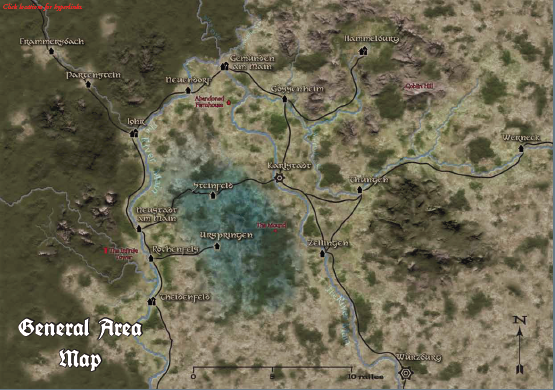
There are 17 settlements in lower Franconia, including Karlstadt (which is significant enough to get its own separate section). Since the focus of the adventure is on the Big 2, most of the others don't have much in the way of detail beyond a few sentences each. The GM is encouraged to develop unique flavor for the areas the PCs find interesting instead of trying to railroad them to the major areas.
Given that typical adventuring gear is needed for the war effort, the prices of most goods is multiplied by anywhere from 2-7 times normal.
Frammersbach is a major supplier for the Empire's army in the region, and as such nothing is for sail as the military already ordered everything of use to be shipped in wagons (which are currently being loaded up by the time the PCs arrive).
Gemünden am Main is a largely abandoned town, 100 people left, as it will be one of the first in the Swedes' war path.
Gössenheim is a ghost town with only 24 people left who are all siblings married to each other. They're going around the farms and slaughtering the livestock left behind to prevent the Swedes from using them.
Hammelburg is a wealthy valley town known for its quality wine. Figuring that the Swedes will go out of their way to seize their alcohol, most of them fled to Würzburg.
Lohr is as large as Karlstadt. It's suffered the worst of the region's witch-hunts, and almost everyone in town is a devout Catholic. A garrison of several hundred soldiers is camped to defend the town, but everyone fears that this will not be enough (it won't).
Neuendorf's only citizens are those old folks too stubborn to flee. They're incensed about the situation in Karlstadt, enough to ally themselves with the Swedes if they promise to eradicate the Seven.
Neustadt am Main is home to a large monastery of Benedictine monks, who will give refuge to PCs in need of aid (but will try to steal and dispose of obviously magical and "ungodly" items). They're disapproving of the Prince-Bishop's recent policies, but they view Karlstadt's new rulers as blasphemy. They know information about 2 dungeons in the region (the Infinite Tower and the Mound), but will warn PCs away because they're "places of fell pagan power."
Partenstein is home to a gothic church, and the citizens are not under the territorial domain of the Prince-Bishop. They figure the Swedes will ignore them.
Rothenfels has an inn and a heavy influx of refugees in town. Late in the day, a long shadow shaped like a tower casts itself over the village. No such tower exists.
Steinfeld is now mostly swampland, only a few buildings above water level. The inhabitants have long departed, and giant malformed insects attack anyone who stays around for too long.
Theidenfeld is unremarkable, except that a traveling circus is in town! Nobody's attending, and the sideshow attractions have an empty feel to them. They're so desperate for visitors that the entrance fee is waived for the PCs.
Thüngen is under the thrall of bandits. They extort any valuables from travelers passing through, and the townsfolk cooperate because all the children are locked in a barn (which will be set ablaze if anyone tries to stop them). The bandit's leader is a gambling addict and makes all major decisions with the roll of a pair of dice. Very Two-Face like.
Urspringen appears abandoned except for a single clinic. Those too sick to leave are cared for by a doctor, who cannot help them anymore. He is secretly slitting the throats of the townsfolk, justifying it that a quick and clean death is far better than torture at the hands of the Swedish Army. He believes he'll go to Hell for this, but accepts this.
Werneck is well out of the way of the Swedes, but the locals are frightened of another pressing problem. Someone, or something, is silently going around at night, ripping the throats of villagers. The locals believe there's a vampire in town, and are dragging people out into the sun and conducting house-by-house searches nightly, but to no avail.
Zellingen is largely abandoned, and the few remaining people sell supplies at exorbitant rates (3d6 times normal price).
Würzburg is the regional capital, a city of over 10,000 people. Thanks to a high walls and the majority of its trade routes going south to Nuremberg, life continues on as usual for the time being. Prince-Bishop Franz von Hatzfeld, has some diplomatic contact with the Swedish King Adolphus. The King's messenger told the Prince-Bishop of Karlstadt's situation, but the Prince-Bishop views this as a trick. Trying to take back Karlstadt would weaken Würzburg's forces enough that they'd be completely unable to resist the Swedish army.
However, the Prince-Bishop has placed a bounty on the Seven's heads, which must be delivered to him. If successful, he'll present the heads as pikes at the entrance as a show of good faith and to use it as a way to unite Catholics and Protestants against Satan. This is the only way in the adventure that will save Würzburg from being burned to the ground by the Swedish army.
The city is in the throes of a witch-hunting hysteria. People are afraid that what happened to Karlstadt will happen here, and accusations against women and girls are being tossed left and right. At least 15-20 women a day are arrested, to the point where there's entire pens and cages being used as impromptu prisons. The authorities figure that even if a lot of them are innocent, being hung or drowned as a witch will be far more merciful compared to what the Swedish soldiers will do to them. Just like real-world witch trials, innocence involves getting killed via drowning or crushed by a rock ("if she floats or survives, she's a witch!"). Guilty ones are hung from trees, stripped of all clothes and valuables, and after the trial the children beat the corpses with sticks as part of a game. We even get a full-page picture of this on one of the pages, with a crowd gathered around the hanging and bleeding naked corpse.
Oookay.
The image isn't as graphic as you'd think, as the perspective is far away and the crowd itself dominates the picture instead of the dead woman. But still...
A few males have been accused of witchcraft, but their trials are much more fair and won't result in inevitable death on an innocent verdict.
PCs can try to free the women, but they'll be branded as witches and attacked by guards in the process. They can free them, but it will be rather hard to do so.
Continues below, with details on Karlstadt proper.
Karlstadt
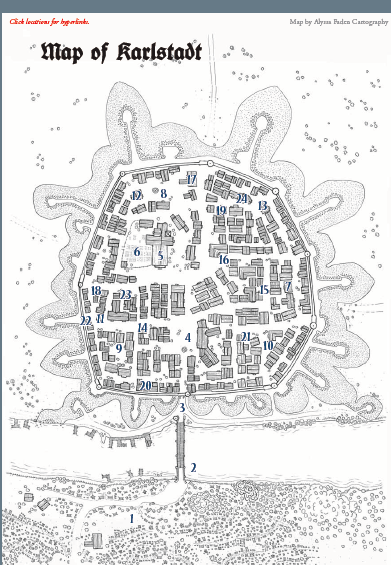
Karlstadt is sort of the 'center' of the module. It is where the major players are located and provides additional adventure fodder in the case of rumors, information from the Joy, and a few interesting locations.
Karlstadt originally had a population of 1,500 people. Over the period of several days this number has doubled within the walls, with several thousand more outside. This refugee colony is full of people still hoping to get inside, and the Seven do not extend their authority out to the camp proper. Most live in makeshift homes, ranging from upturned carts for shelter and some tents. Ruthless and violent figures are the unofficial leaders of the place, committing crimes out of view of the milizionäre and taking what they want.
The town is walled and surrounded by a moat, with a single bridge acting as an entryway. The milizionäre patrol around the walls, and a dozen guard the bridge. Those passing through must submit to a thorough search, and people who try fighting through will sound the alarm and have to fight one of the Seven's monsters. All further entry into the town will be closed if this happens, and due to this refugees will aid the milizionäre in stopping the intruders. People found to be carrying weapons will be arrested, otherwise those who qualify for entry must hand over all of their valuables except the clothes on their backs "for the greater good." The milizionäre genuinely use these valuables to the people living inside as determined by what groups need it most.
Considering that sneaking into town with equipment intact means getting past the guards and blending in with the crowd, I can't see PCs using Karlstadt proper as a base of operations. Even leaving equipment behind almost certainly results in its theft due to the refugee colony's rampant crime. The most useful means of travel to and fro is an old smuggling tunnel, which is located in an otherwise nondescript house. The Joy knows about it, and can give it up as an answer to a question.
The situation within the walls is desperate. Karlstadt is stretched to its absolute breaking point in terms of living standards. The population is so high that housing is full and many people are sleeping in the streets; regular supplies of food via merchant caravan is not enough to keep anyone full; and common social services are nonexistent.
There are 21 briefly-described locations within town, including the Seven's individual residences (although the Mother and the Joy abandoned theirs).
1.) A black market of forbidden goods operates out of a large multi-story residence; the Seven know about this, but since no weapons are traded they send in their servitor creatures to scare people away and keep up appearances.
2.) The smuggler's tunnel is half a mile long. It connects to a farmhouse and the cellar of a house in Karlstadt.
3.) A group of Catholic supporters of the Prince-Bishop hid a stash of several dozen weapons (including swords, axes, and firearms) in their meeting house. They plan on violently overthrowing the Seven once they feel confident enough and learn the weaknesses and abilities of the witches and their servitor creatures.
4.) The town inn is used to hold the town's injured, crippled, and sick. Nobody in town has medical experience, so the best the milizionäre can do is bring them food.
5.) A small town square serves as a social outlet and escape from the hardships of life. Townsfolk hold regular musical sessions for entertainment, although none of them are professional musicians.
6.) A growing number of Catholics are holding religious services in a private church, but they're using smuggled bread and wine to perform communions. They're increasingly outspoken about their beliefs, and 1d6+1 days form the adventure's beginning someone will burn down the house with everyone inside.
Other locations are less notable, but contribute to the sense of despair, or reveal more of the individual Seven's personality in terms of living residence. The Defender has a posh manor nobody's allowed inside; the Defiler's residence is an apartment full of broken furniture used to board up the place; the Reminder has converted her house into a printing press and classroom (for creation of spellbooks and teaching others magic); the Watcher's home is filled with religious paraphernalia; and the Maker's house has been torn down and destroyed (although nobody knows why).
Thoughts so far: The small settlements are nothing special, and don't really have much in the way of adventure fodder. Karlstadt is a much more interesting location, and I like the multiple sources of conflict and power struggles going on (the Catholics, the conspirators, the black market).
Next time, the dungeons!
Abandoned Farmhouse
Original SA postLichtenstein posted:
I sort of like the mood of this adventure so far and anxiously await the moment when it turns all grognards.txt.
There isn't really a big downhill spiral into creepville in BTAM. If anything the stuff is lightly sprinkled throughout the adventure rather than focused into one place.
On with the review!
Better Than Any Man Dungeon 1: Abandoned Farmhouse
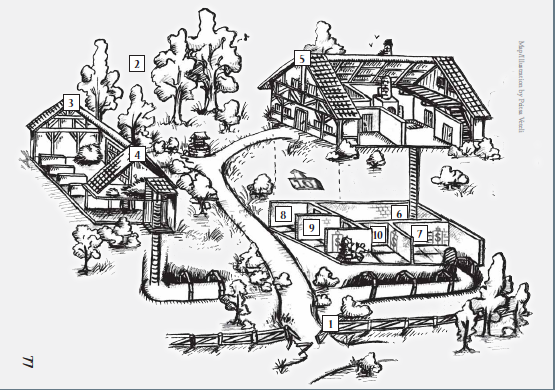
So there's a total of 4 dungeons in the region which the PCs can hear about through rumors and NPC interaction. They are the Abandoned Farmhouse, once owned by a family of cultists and now inhabited by bandits; the Mound, an ancient place built by a long-forgotten race and now inhabited by a necromancer; the Infinite Tower, a magical building which has an endless layer of floors and inhabitants; and Goblin Hill, a sort of megadungeon comprised of caverns, the Insect Shrine, the Bürgerfriedensmiliz Headquarters, and the Lair of the Insect God. We'll cover them one per post (with Goblin Hill itself made up of 4 posts).
The Abandoned Farmhouse is in the northwest area of the map. Decades ago the Braasch family was successful and prosperous. In secret they worshiped the Insect God in an underground cellar, and taught and practiced magic. Eventually the community suspected the latter, and killed all the men as the women and children fled.
A group of bandits led by Gunther Mohl has fallen on hard times. Their horses are dead and they nearly escaped death at the hands of the authorities, so they're using the old Braasch farmhouse as a temporary base. The place has a reputation for ghosts and black magic, so the Mohl and his men figure that nobody would bother them as long as they stayed.
Unbeknownst to them, one of the Braasch patriarchs still lives on as a ghoul, hidden in a cellar room accessible only via secret doors (room 10). A shrine to the Insect God in the room grants him supernatural resilience, and he cannot be Turned by Clerics unless they'e between the ghoul and the alter. Braasch's rather slow and frail (3/4ths normal human movement, 2 Hit Dice), but offensively he packs quite a punch (bite and claw for 1d8 damage each) and he's got good Armor (15).
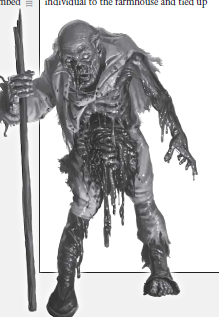
Gunther's a 1st level Fighter with Armor 14 (leather), and a sword and dagger and pistol as weapons which deal 1d8 damage each. This is probably a typo, as daggers do 1d4 damage in LotFP.
He has a map he took off of a patrolling milizionäre, which is actually details a backdoor into the Bürgerfriedensmiliz Headquarters. Gunther knows this from scouting the area. He has keys which unlock most of the doors and chests in the farmhouse.
Six bandits are part of Gunther's gang, and they're all 0 level humans with no worn armor, a sword, and two daggers each.
The group sticks to the cellars below the farmhouse, and they're particularly afraid of being spotted by passing patrols (and that glass tiger monster). Two of minions keep watch in the barn's hayloft (room 4) and are poorly disguised as zombies (covered in flour and dirt) to scare away intruders. There's a hidden trapdoor which leads down to the secret hideout (room 7).
A couple men keep watch on the farmhouse's (room 5) upper level for intruders. Between them and the pair in the hayloft, the bandits have an overhead view of the front gate (room 1) and trees (room 2). The second underground entryway is located in the cellar (room 6). The bandits can use these connecting passages to move to and from the two buildings without crossing out into the open.
The various cellar rooms (7-9) contain living accommodations and supplies for the bandits, as well as a trapped chest containing their ill-gotten loot. The treasure chest contains 1d6x100 silver pieces worth of copper and silver coins. A good haul overall.
Adventure Hook
The place comes off as a tutorial dungeon of sorts. It's not big and expansive, the bandits are not confined to set rooms and will retreat into tactically sound areas, and the lion's share of treasure is in one room. It's really a stand-alone encounter which doesn't deeply tie in to the greater plot, although the Insect God altar will be recognizable later on once the PCs get into the Insect Shrine. The bandits do occasionally come to Karlstadt for supplies in groups of one or two and spend time at the Joy's bar, so she can tell the PCs about their plans and lair.
Raggi offers an adventure hook to motivate the PCs. A few of the bandits will kidnap a child from Karlstadt's refugee colony for a 1,000 silver piece ransom. If the parents want the child back, they must deliver a pony/mule with saddlebags full of the money to the barn, and then the child will be hosted onto to it blindfolded and gagged to go back outside.
Problem is, the parents don't have that kind of money, and the bandits did not consult with Gunther of this plan (who's furious because it compromises their secrecy). They offer to pay the PCs 50 silver (of which they lost everything and had to do a lot of degrading things to scrape up) if they can return their child alive.
The child is being held in the cellar near one of room 10's secret doors, where the bandits will retreat. If Gunther dies or falls unconscious, the child will scream as the undead Braasch springs out to kill and eat him/her. They have 2d6 rounds to save the child's life (the ghoul takes his time to gloat over his catch). The bandit's first priority will be to save the child, even cooperating with the PCs to kill the ghoul.
It should be easy to save the child, provided there are enough PCs and bandits left alive to take action. 2 rounds is plenty of time for even 3 people to threaten Braasch, whose priority will shift towards his new enemies. And if 5 people with a +1 to-hit roll wail on him, each has a 65% chance of hitting him. Braasch himself has a +3 to hit, meaning that he'll connect with the bandits easily enough but won't get past the defenses of a heavily-armored Fighter most of the time.
Thoughts so far: the Abandoned Farmhouse is challenging, but manageable for a group of 1st-level PCs. The bandits are all weak and don't have any magic (only the leader has a one-use ranged weapon). If the fight is located close quarters in the cellars and the bandits still maintain superior numbers, they can overcome the party.
Next time, the Mound!
The Mound
Original SA postSaguaro PI posted:
Congratulations, Raggi, you did what you thought would be impossible and what your previous work indicated was, created an adventure better than Keep on the Borderlands . This thing isn't without problems, but I'm kind of awed the guy who brought us Death Frost Doom and wrote an essay on how originality sucks could create something that's actually kinda interesting.
To be fair, Death Frost Doom was written in 2007, and he's had a lot of time to improve in that department. With some exceptions, many writers and tabletop game designers' work tends to get more refined with time; practice makes perfect.
Anyway, the next section:
Better Than Any Man Dungeon 2: The Mound
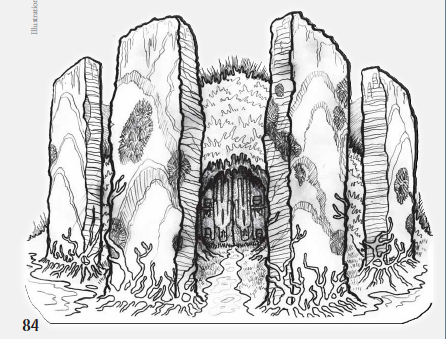
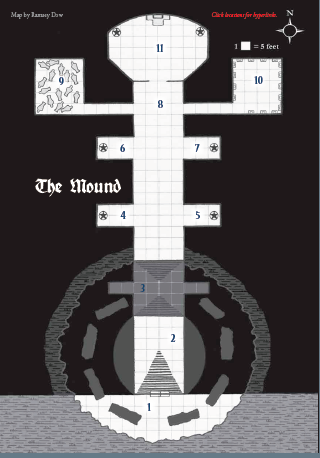
The Mound is a millennia-old shrine to the Insect God once inhabited by a forgotten race of creatures. Today it's the home of Willibald Schwartz, a depraved necromancer who conducts arcane experiments in its halls. The Glass Tiger (from Countryside Encounters) is one of his creations, usually stalking the region for people to kill and bring back to its master.
The Joy can tell the PCs about Schwartz, mainly that he's insane and should not be crossed and that he's looking for some hired help. The Monks of Neustadt am Main also know its location, but not its current occupant.
The dungeon itself is rather straightforward, as evidenced by the map, but very, very, lethal. Room 3 is trapped, the floor covered in explosive flammable oil which deals 3d10 damage on a failed Save vs. Breath Weapon if anyone crosses with a torch. Rooms 9 and 10 are inhabited by 16 skeletons each in sarcophagi, who will animate if anybody removes even a single piece of treasure from the tombs.
Rooms 4-7 are pedestals with inscriptions in a long-dead language detailing the exploits of various goblin folk heroes (Alderman Toony Rabbitmangler, Battlemaster Talon Berrycrusher, etc.) and their campaigns against the “Tall Ones.” The original statues themselves are long gone, replaced by the petrified remains of Schwartz’s child victims in various macabre states (one pulling his own skin off like a shirt, another with faces of other children sown into him, etc).
I personally feel that this detracts from the “weird fantasy” vibe. Goblins are so cliché and iconic in tabletop games that it removes much of the horror when they’re identified as much. The silly names make me think of Pathfinder’s goblins, which are pretty much comic relief. However, Raggi had something going with the replacement statues: it gives the impression that the Mound’s original inhabitants were really fucked up and had nothing in common with the present culture. And even if they find out otherwise, the horror is not diminished but instead shifts towards Schwartz.
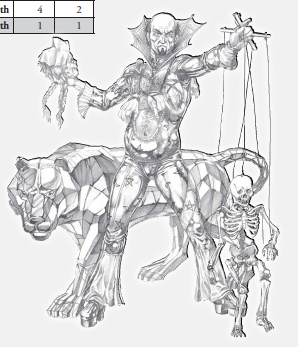
As for Schwartz himself, he’s a 17th-level Magic-User with 36 spells prepared (ranging from 1st to 9th level); in addition to his Glass Tiger minion, he has a rather powerful unique spell which could allow him to cast multiple spells per round, and a marionette which can summon 2d6 spectral ghosts a round (but only 12 maximum at any given time). He doesn’t have a typical spellbook per se; rather, room 11 is his entire spellbook. His research notes and scrolls are carved into the walls of the laboratory, which used to be the main altar room of the Insect God. And he also has a spell which allows him to see in dark as long as he has a human head touching his body, so he can see the PCs down the hallway if he’s in room 8 (the corridor’s end).
So how are the PCs supposed to go through this dungeon without dying horribly? Well, Schwartz is not interested in fighting, unless the PCs are locals, try to steal from the Mound, or otherwise indicate that they’ll compromise his location to outside parties. The necromancer knows of the Mound’s origins, and the inner circle of Bürgerfriedensmiliz who wish to revive the Insect God. If they successfully awaken the deity, it will be none too pleased to find out that Schwartz desecrated one of its holy shrines, so he has an incentive to prevent this from happening.
So Schwartz will tell the PCs that the cult needs the Gem of the Insect, an old statue, to complete the awakening ritual. He knows the time period when it was lost and its general location (the Insect Shrine in Goblin Hill), and has prepared a scroll which can travel back the caster and a small group back in time. Once the duration ends and they come back to the present, they must use that knowledge to find its current location. If the Gem is broken, the God will slumber forevermore.
Schwartz will not directly help the PCs, or offer them a reward. If pressed or asked why they should trust him, he’ll mention that the Insect God will kill millions at the very least, and potentially all human life. He only kills about a dozen people a year.
Around days 8-11 from the campaign start, the Swedish Army will send a legion of troops to the Mound in their sorcery eradication attempts. They will kill Schwartz and destroy all of the “pagan” creations in the process, meaning that the PCs will have no way to stop the Insect God unless they’re able to figure things out on their own.
I find this scenario hard to believe. Even though the Swedish Army at the time was one of the most advanced in the world, LotFP spellcasters still have a bunch of tricks up their sleeves at high levels. All but 7 of Schwartz’s spells (which are the unique ones) are for the DM to determine, and while he might not be all to kill thousands of troops in a short amount of time, he can out thwart them. He can hold up in the Mound and will easily notice a large group coming inside, enough to formulate tactics and plans.
An LotFP Magic-User can:
Cast Protection From Normal Missiles as a 3rd-level spell, which provides complete immunity to small non-magical projectiles (including bows, bolts, and bullets) for 1 round/level (round equals 6 seconds).
Protection From Normal Weapons as a 4th-level spell, which does the same as the above but for all non-magical weapons and people of 4th-level and higher can affect the caster normally.
Cast various Invisibility spells from 2nd-7th level which last 1 turn/level (1 turn equals 10 minutes), ranging from 10’ radius to being allowed to attack and so forth.
Gaseous Form and Dimension Door as 3rd and 4th level spells for escape.
Stone Shape, Wall of Force/Iron/Stone as 5th level spells, along with Stinking Cloud and Web as 2nd level spells for battlefield control.
Okay, you get my point.
Magic Item and Spells
Next section discusses Schwartz’s unique magic item, The Dead Marionette. It’s a bar with strings made from human hair, and it has 3 powers which can be used once per round as long as an intact human skeleton dangles from it.
One power allows the user to summon 2d6 1 hit die spectral duplicates of the caster, to a maximum of 12 at any time. They ignore worn armor and deal 1 hit point of damage, but can be affected by normal attacks.
The other power can take physical control of a target on a failed Save vs. Paralyzation, except they have full control of their mouth (and thus can’t cast spells against their will).
The third power can break a target’s bones on a failed Save vs. Magical Device. Deals no hit point damage, but imposes penalties based upon the area effected (ribs halve carrying capacity, legs reduce movement, etc). Takes 1d4+1 weeks to heal naturally, healed instantly with a cure spell provided said spell isn’t used to restore hit points.
Even though it’s unlikely the PCs will get access to this item in the adventure, it can be a really powerful item for them. Aside from looking creepy as fuck and hard to conceal and carry if using a skeleton, it has no negative effects on the user. It can be used an unlimited number of times unless the target succeeds on a save (in which case the skeleton crumbles). Finding replacement skeletons is easy, given that the PCs are traveling adventurers.
Also detailed are 7 new spells. All but 2 of them are 1st level, with Animate Hands being 2nd level and Perfect Dark Vision being 3rd level.
quote:
Animate Hands
Magic-User Level 2
Duration: 1 round/level
Range: 10’/level
This spell animates any severed human or human-like hands (or hands attached to severed limbs) within range, allowing the caster to control them as natural extensions of his own body.
Pairs of hands can be used by the caster to cast spells independent of other actions taken. Spells are of course counted against the caster’s prepared totals. By itself, a hand cannot carry items or attack for damage, but a hand can enter mêlée and distract its opponent by climbing on them; a saving throw versus Paralyzation is required or the harassed combatant suffers -1 to hit and a 1-point Armor penalty. These effects are cumulative, and a victim must save against each hand’s effects each Round.
Hands: Armor 12, 0 Hit Dice (1d4 Hit Points), Movement 60’ (30’ if attached to a limb), Morale 12.
This works as a nice debuffer against single opponents, but its ability to grant additional cast spells per round is the bomb. Granted, LotFP spellcasters don’t get bonus spells per day from ability scores or at-will cantrips like in 3.X games, but it’s a worthy trade-off assuming that the Magic-User’s would otherwise cast multiple spells over the combat encounter.
quote:
De-Age
Magic-User Level 1
Duration: Instantaneous
Range: Touch
This spell causes a willing subject to instantly become 1dX years younger, with X being the level of the caster.
If the maximum effect occurs, it adversely affects the subject, resulting in the loss of an experience level as well (with experience points being set at the minimum for the new level). A Level 0 character will instead become lobotomized, effectively no longer possessing an intellect at all. In either case, the character must then save versus Magic or de-age a further 1d30 years.
A character that falls to zero years of age becomes a fetus. A character that falls below zero years of age ceases to exist, as does all carried equipment and other peoples’ memories of that character, and all actions that character has ever performed are undone.
If the Referee’s game includes Elves, this spell does not affect them.
Except on a few levels, this spell requires either an online dice roller or one of those fractional things where multiple numbers on a die represent a single result. For a 1st-level spell, this can be quite powerful. Not only do you have the chance of permanently screwing over the target, you can even remove him out of existence entirely!
quote:
Deflect Damage
Magic-User Level 1
Duration: 1 round/level
Range: Self
This spell attempts to assign damage suffered by the caster to another nearby creature instead. When the caster suffers damage while under the effects of the spell, another creature within 30’ of the caster is randomly selected by the spell.
If this victim fails a saving throw versus Magic, it takes the damage instead of the caster. The damage transferred is never greater than the level of the caster each Round and if the transferred damage is enough to kill the victim, any excess is transferred to another random target. Damage self-inflicted by the caster will not be transferred and the damage is never transferred back to the person dealing the damage in the first place.
A good way for the party Wizard to up his survival rate, but the randomness of it decreases its usefulness unless allies give the caster a wide berth.
quote:
Journey to the Past
Magic-User Level 1
Duration: 1 turn/level
Range: Self
Upon casting this spell, the caster and all persons touching him (and their personal gear) are transported to a pre- determined point in time in the past. The transported characters are able to interact with and influence events at that time; they are there! When the duration expires, the subjects return immediately to their own time at the same point in time they left from. Onlookers will merely see them blink out of existence for a fraction of a second.
The point in time is fixed with the spell; each different point in time must be researched and learned as a completely new spell. The time associated with the spell will be constant. “Four o’clock in the afternoon on February 4th, 1602” is an allowable example (and will be tied to “four o’clock” where the spell was first transcribed, not the local four o’clock if different!), “Thirty minutes before casting” is not.
The spell does not transport its subjects across space*; travel occurs at the exact location of the casting only. Unwilling subjects can save versus Magic to remain unaffected. No people or objects from the past will be transported back to the present when the spell ends. The spell cannot be ended prematurely, but the caster can specify a shorter duration (in 10-minute Turn increments) at the time of casting.
* The Referee who declares that subjects of this spell are transported into space because they did not take into account the movement of the planet or the sun through outer space is an idiot and deserves to lose all of his players.
Schwartz’s spell sends the subject(s) back to July 14th, dawn, 10,000 BC. Since he’s 17th level, PCs would have nearly 3 hours to go through the Insect Shrine to find the Gem.
This spell is also potentially powerful as well, even considering its fixed point in time. Research a new spell variant tailored to a certain day of historical significance, travel back and alter things and change the course of history.
It doesn’t specify if objects from the present can be abandoned. I assume from the reading that things from the past can’t be taken forward in time.
quote:
Perfect Dark Vision
Magic-User Level 3
Duration: Special
Range: Touch
This spell imbues a severed head of the same species as the caster with the ability to grant its possessor the ability to see without light. The head must be in direct flesh-to-flesh contact with the subject to function.
The spell ends when flesh-to-flesh contact ends, or when the flesh completely rots off the severed head (3d4 days after death in normal conditions, half as long in warm conditions, twice as long in cold conditions, a matter of Turns in insect- infested areas of the Insect Shrine, etc.).
If the head is artificially preserved by any means, including the Plastination spell, it cannot be used to power the spell.
Long-term duration darkvision. Unless you cut a hole in your clothing and let a severed head touch you there, you’re going to look like a creepy fuck walking around with it in the open.
quote:
Plastination
Magic-User Level 1
Duration: Permanent
Range: Touch
This spell coats dead organic matter in a clear shell which perfectly preserves the subject matter. The casing material is in no way indestructible; any blow intending to destroy or penetrate it will do so.
Due to the nature of the casing material, that which it preserves is no longer organic material. Therefore food cannot be preserved in this manner and neither can sacrifice victims, without either becoming unfit for purpose.
Pretty much Gentle Repose.
quote:
Read Brains
Magic-User Level 1
Duration: Special
Range: Self
This spell allows the caster to use the content of a character’s brains in lieu of a library for magical activities. The brains must be extracted from the head and preserved to be used. A Magic-User’s brain counts as 1000sp per level of the Magic-User; Elves’ brains count as 2000sp per level of the Elf; Clerics’ brains subtract 1000sp from the effective library level per level of the Cleric; all other leveled characters’ brains count as 500sp per level; and 0-level characters’ brains count as 100sp each. However, the maximum benefit that the caster can gain from this spell per project is 1000sp for every level of the caster.
Once the magical project is completed, whether successfully or not, the brain(s) used are smoothed out, dried up, and useless.
Now your Magic-User can learn new spells and scribe scrolls while on the road! Provided you have enough brains to do so.
Thoughts so far: This section of the adventure is rather railroady. The PCs need Schwartz’s help if they’re planning on putting a stop to the Insect God’s cult, and they can’t really fight him and take his stuff without a guaranteed Total Party Kill. It also leaves open the question of why Schwartz hasn’t tracked down the Gem himself.
Aesthetically speaking, the dungeon and the new material (marionette, spells) are highly appropriate and very thematic of a depraved necromancer.
Next time, the Infinite Tower!
The Infinite Tower
Original SA post
Yeah, the uber-powerful necromancer and the goblins are kind of a low point which doesn't gel well with the rest of the module. But the next dungeon's pretty interesting and a lot less railroady.
Speaking of old-school "you're fucked, no saving throw" shenanigans, there's an insidious little bit in the next dungeon which can effectively make the PCs bypass the whole adventure accidentally, and in a bad way. Hint: it involves an impossibly long hallway.
Better Than Any Man Dungeon 3: The Infinite Tower
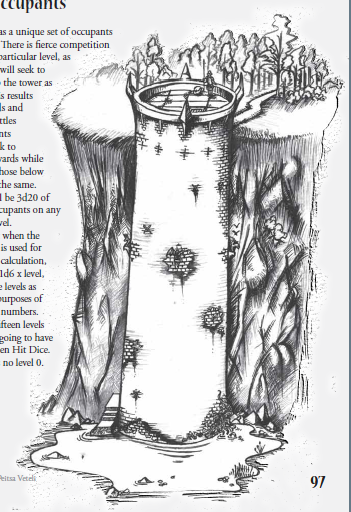
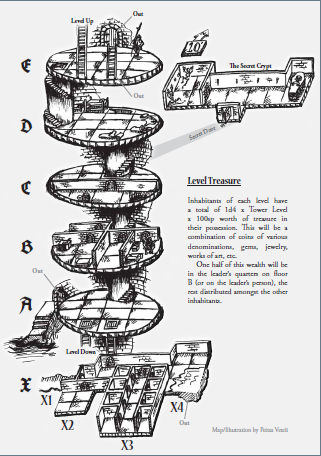
Located on the far western side of the map, the Infinite Tower is built into a cliffside at the edge of a pond. The tower's origin is unknown, having been there since before humanity evolved into homo sapiens. It has no connection to the Seven, Schwartz, the Insect God, or the German/Swedish power players. It's a side-trek; Raggi feels that more adventures should have people, locations, and events untied to the main plot because it gives a sense that the world is bigger than just the PC's concerns.
The tower's interior occupies an extra-dimensional space. Every level looks like the one on the map. If someone enters from the outside from up top, they'll enter through the door on Section E on Level 1; if someone enters through the steps on bottom, they'll enter through the door on Section A of Level 1; if the PCs manage to go through the underwater entrance through the cracks, they'll enter through the rightmost room on X4 of Level 1.
Travel between levels is done via ladders on A and E, and if someone exits through the A/E/X4 routes on any floor they'll find themselves outside the Tower. They enter back at Floor 1, and must climb/descend the Tower again (meaning that occupants on floors other than 1 never leave). Floors below 1 are marked in negatives (like Basement 1, Basement 2 in video game dungeons), as there is no Floor 0.
The tower's interior seems to go on forever, and nobody has found a dead end yet. There are millions of people and monsters living amid the Tower floors currently, and each level has 3d20 inhabitants of a specific type. The inhabitants' primary goals are to defend their levels from the others, while at the same time plotting to conquer the next higher level. They get their food and water supply from X4, which has fish, and have an assortment of treasure equal to 1d4 x Tower level (negatives count as positives) x 100 silver pieces, with the lion's share on the level's leader or his/her quarters.
Sections A and E act as guardrooms against the adjacent levels. Section B is the private quarters and strategy room of the elite occupants (no suggested changes to game stats). Section C is a common area with a storage room and secret door leading out to the cliffside and the sarcophagus room. Section D is a sleeping area, while Section X has 4 rooms.
Most of X's rooms are mundane (X2 is storage room, X3 are family living quarters, X4 is fishing area), but X1 has a really nasty trap:
quote:
The passage is a time trap. The corridor itself is endless. Anyone walking down this hall is lost for 1d6x10 years before the passage leads back here (it will not seem to turn). There is a 50% chance that the person lost in time will come back this many years before he left, and a 50% chance that he will come back this many years after he left. Whenever he makes his return, the person lost in time will always return to the same level of the Tower. Each level’s inhabitants are aware of the effect here and post guards to watch the corridor.
No, there's no save against this. A single PC goes down, and they're pretty much out of the campaign. The entire party goes down the passage, and they whole adventure passes them by (the Thirty Years War is over by 1648, and the Seven, the Citizen Peace Patrol cult, and Schwartz are all long dead). Actually, on days 8-11 the Swedish Army uses a lot of gunpowder to collapse the Infinite Tower, killing everyone inside and spilling their blood and guts out into the water supply. The river will run red for weeks. Which begs the question of whether or not PCs in the passage trap count as being inside, and if not, what they return to at its end.
Generally, occupants level 1 and up are humans with class levels, while the first five basement levels are empty. Basement levels 6 and down are inhabited by monsters. The occupants become stronger the farther one goes up or down, with examples for the first ten levels either way. It's up to the Dungeon Master to make up inhabitants beyond these 20 levels, but they're supposed to get stronger and stronger.
The first six levels up are 0 and 1st level guys, the first 2 being 0 level peasants and militia members, with 3-6 containing 1st level Specialists/Fighters/Clerics/Magic-Users, representing thieves’ guilds and religious orders and the like. Levels 7-10 have Magic-User orders of increasing probable power, starting with The Mystic Gathering of Atlantis of 2nd-level at 7, the Hidden 1d4 level , the Knowers of levels 1d4+2, and finally ending with the Installed at levels 2d6! It guess it really limits the PCs’ ability to explore the Tower when the first few levels can turn into an unstoppable force (the 3d20 number is widely variable alone), but I can see how the routine can eventually get tedious the first few times.
The monsters increase in power and difficulty at a far greater rate than the humans. The snake men on basement level 6 have Armor 14 and 3 hit dice and a poison attack which deals additional hit point damage. Basement 7 has Sulpher Men, with Armor 16, 4 hit dice, and a 30’ cone breath weapon of 1d6 fire damage. Basement 8 has men of Living Crystal, with 18 (!) Armor and reflect all magical attacks back at the caster; these guys are nearly untouchable for non-Fighters! The Lizards of Basement 9 don’t have any special abilities aside from Armor 18 and 8 hit dice. Basement 10’s monsters are Soul Suckers, with Armor 20 and 6 hit dice and a soul sucking attack which drains 1,000 experience points per hit!
These Armor scores might sound rather high for low-level adventurers, but it’s even more egregious in this RPG. I'll explain in this quote below:
Armor and to-hit posted:
For an overview, LotFP uses the ascending defense system of later D&D Editions, where a higher Armor (Class) means better protection. The average unarmored human has an Armor of 12; Leather Armor grants a base 14, chain 16, and plate mail 18. Magical spells and high dexterity can adjust the base further. Characters’ attack bonuses are a base +1 and modified by Strength or Dexterity (depending on whether it’s a melee or missile weapon). The Fighter is the only class whose attack bonus increases with level: it starts at a +2 base at 1st level and increases by 1 every level thereafter. This is meant to make combat less certain for all but the specialized Fighters (a Fighter with plate mail is king of the battlefield). Monsters' attack bonuses advance as Fighters (with an equivalent level equal to their Hit Die).
In the main rulebook, Raggi advises to keep the Armor of monsters low, with an 18 or more representing very dangerous and exceptional beings. But this rule is discarded at times in Better Than Any Man, and more than a few creatures cut it close, from Tower occupants to random encounters in Goblin Hill.
There are very few weapons which grant a bonus on to-hit rolls, and even they have conditions. The polearm grants a +1 to hit opponents with a base Armor of 16 or better; the light crossbow can ignore 2 points of Armor (even if the target is unarmored), the heavy crossbow 4 points, but both have longer reloading times; firearms (both pistols and rifles) can ignore 5 points of Armor but can only be shot once per combat encounter (they take forever to reload). A few weapons, such as the rapier, apply a penalty of -2 against very high (15-16 or better) base Armor scores.
So a 4th-level Fighter with a polearm and 16 (+2) Strength will get a +8 bonus under the right conditions, but that requires a high die roll at character creation and even then will miss 45% of the time against these Tower monsters.
This system might be workable in a base LotFP game, where combat is to be avoided unless the PCs are sure of themselves and most monsters have 12-15 Armor scores. But when you’ve got small groups of Armor 17 monsters showing up in dungeon encounters, your non-Fighter PCs are soon going to start carrying around heavy crossbows as their main weapons.
Finally, every floor has a secret sarcophagus level, unknown to the inhabitants. A Crypt Occupant guards the treasure, with some rather weak base stats (Armor 12, 1d4 hit die, 1d6 rend), but has a special ability determined by an accompanying random table (stuff like breath weapon, Constitution drain, skill points in Climbing/Sneak Attack/Stealth, etc). The room’s treasure is 1d6 x Tower level (negatives are treated as positive) x 500 silver pieces. And a 1% chance of a single spell scroll of level 1d6+3!
Thoughts so far: The Infinite Tower is a cool idea, but when it comes to execution I have mixed feelings. At first it appears to have a steady difficulty curve, but the 3d20 number throws any form of gradual progression out of whack. The monsters get too powerful too quickly. Saving the Tower for several sessions later is not possible, given that the Swedes will destroy it around week’s end, limiting its appeal.
Next time, Goblin Hill Part 1: Caverns!
Goblin Hill - Caverns
Original SA post Better Than Any Man Dungeon 4: Goblin Hill-Caverns
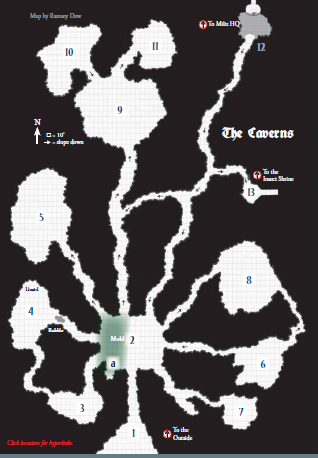
Goblin Hill itself is an unremarkable hill roughly ten miles northeast of Hammelburg. Nobody remembers the origins of the name, and it's not known for any weird stuff by Franconia's inhabitants.
Within the hill is a complex underground system of natural caverns and artificially constructed tunnels and complexes. The Mother and the Bürgerfriedensmiliz use the place as a base of operations. Goblin Hill is so big that it's split up into 4 dungeons:
The Caverns, a cave system full of insects and lightly patrolled by milizionäre.
The Insect Shrine, a prehistoric temple to the Insect God.
The Bürgerfriedensmiliz Headquarters, known to every member of the Seven and the milizionäre, but none except the Mother and the hidden order of cultists have ever been inside.
The Realm of the Insect God, a forsaken and unholy place where the God itself lairs, along with millions of its monstrous servitors.
We'll be detailing the Caverns first.
The Cavern entrance is hidden from view by foliage and camouflage; not even the Mother knows about it. Gunther (bandit leader from the Abandoned Farmhouse) has a map to the place and scouted it out, and the Joy can tell PCs the entrance's general location and what passage to take to get into the Headquarters. A sign saying "Welcome!" in German, set up by the Mother, 40 feet away on the trail outside. This seems rather blatant to me; there are many alternatives for wilderness markings people historically used to indicate location (paint on trees, affixed markers, cairn trail markers).
The Cavern complex and the environs outside are infested with bugs, even in winter. Every hour the PCs linger without moving they'll take 1 hit point of damage as the insects get everywhere and under clothes and bite and sting. They quickly spoil rations and make resting inside impossible. Animals tethered in any way will try to break free and get out of the area.
Random Encounters
Generated by a d6 roll, all but 1 one of them involve giant monstrous insects. The other's a patrol of 2d6 milizionäre. It adds some flavor by mentioning that the patrols fashion shields out of giant ant heads; the minions of the Insect God are just as hostile to the cult as it is to everyone else, and as such the headquarters' inhabitants tread cautiously in the caverns. The DM rolls for an encounter once a Turn (10 minutes) the PCs spend in the cavern.
Overall the encounters are quite tough, but in different ways. The giant wasp monster is unimpressive, but is has a Save vs. Poison or die bee sting attack. The giant beetle is half as fast as a human and an average natural attack, but its Armor is 19. The encounter with 1d6 Giant Cockroaches are 2 Hit Dice creatures (but roll hit points as though they had 8 hit dice!). The Giant Horsefly is a fast flyer and has a blood-sucking attack, but it's cowardly and has a low Armor (14). The last encounter, 1d6 Giant Ants, are tough but manageable for higher-level parties (2 hit dice, Armor 17, 1d6 attack, high morale).
The cavern has 13 rooms. Most of them are interesting places with unique encounters.
Room 1's the cave entrance. Room 2 is the intersection area with a giant beetle and dead adventurer with loot.
Room 3 was used as an execution chamber for disobedient and criminal milizionäre, and their shadows remain within the cavern. They will attack anybody who remains for 1d6 minutes; they form out of shadows naturally generated by light, and deal damage with touch attacks. They cannot be harmed except through an Exorcism spell or removing all shadows entirely (by getting rid of all light sources). The skeletons of 6 dead adventurers have loot here, along with a locked chest (which should provide enough time for the shadows to show up if the PCs dilly-dally with it).
Room 4 is home to a basilisk and its petrified victims (the monster's petrified, too, through the use of a mirror).
Room 5 is home to 2 rogue and milizionäre exiled for heinous crimes (why weren't they executed as normal?). They've fashioned a Rube Goldberg network of bones all over the place, so any combat within the room (as well as collateral missile weapons, missed attacks by PCs, and area of effect spells) not performed by the pair will trigger a trap and cause sharpened bones to fall from the ceiling. They're 0 level humans with a pet attack dog, and their familiarity with the area gives them all an insane Armor (19 for the three). I can forgive this, though, for the totally awesome idea for a cinematic combat!
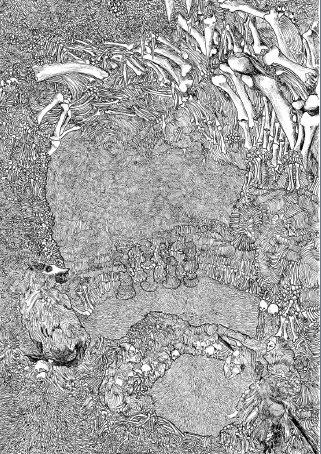
Room 6 is very wet with acid which looks like cave water. Getting sufficiently wet deals 1d8 damage, and anybody who falls asleep here will die as the acid will dissolve bodies over time.
Room 7 is a colony of ooze blobs with precious stones (eggs) in their bodies. Trying to retrieve the stones will trigger an acidic spray. Otherwise they're harmless.
Room 8 contains a black liquid orb suspended in the air. The environment within is breathable and home to an entity known only as the Master of the Sphere.
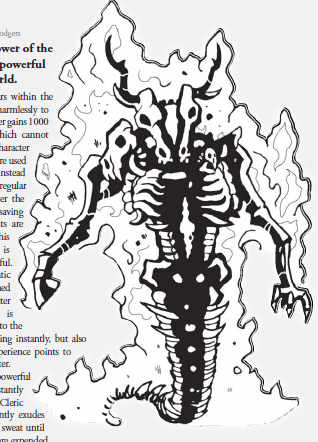
This creature and the sphere have no relation to the rest of the adventure, and is completely optional.
The Master gains its power by remaining within the sphere, and challenges anyone who enters to single combat and tell the others to leave the sphere. It's a rather tough customer: 4 Hit Dice, Armor Class 18 (24 against non-thrusting weapons), an electrical discharge area attack, and a psychic head whip attack which ignores armor. On the upside, it can't heal from any damage.
If a PC does manage to slay it, he or she can choose one of three choices, all of which have insane consequences:
quote:
Stay as master of the sphere and be immortal.
The character is restored to full Hit Points, and will live forever as long as he stays within the sphere. Any others within the sphere will instantly die, their maximum Hit Points being added to the newcomer’s total. If the new master leaves the sphere, he dies. The master may of course be replaced by an interloper defeating him in combat.
Absorb the power of the sphere and be powerful in the world.
The sphere disappears within the character, who falls harmlessly to the floor. The character gains 1000 extra Hit Points, which cannot be healed if the character suffers damage, but are used to absorb damage instead of the character’s regular Hit Points. Whenever the character fails a saving throw, 50 Hit Points are subtracted from this pool and the save is considered successful. This effect is automatic and cannot be switched off. Any other character within the sphere is instantly absorbed into the character as well, dying instantly, but also transferring their experience points to the absorbing character. This newly powerful character becomes instantly Chaotic (losing any Cleric abilities) and constantly exudes a black, oily form of sweat until the extra Hit Points are expended.
Disperse the Sphere
The sphere loses its form and collapses into the cavern, filling it far beyond the original sphere’s volume. The cave will fill to a 15’ depth, and any character whose encumbrance is greater than Unencumbered must shed equipment or drown. The character who defeated the Master of the Sphere will be able to remain buoyant with his own equipment, but not any equipment picked up after the sphere’s collapse. Any other characters within the sphere when it collapses must save versus Paralyzation or be stunned for 2d4 Rounds, and sink straight to the bottom of the newly formed lake if they are at all encumbered.
Options 1 and 3 screw over the characters, so does Option 2 if the PC's a Cleric or any of his buddies remain within the sphere. An effective 1,000 extra hit points is rather nice, though. Especially for this adventure.
Rooms 9 through 11 are where the spiders live, and it's insane. In addition to hordes of tiny poisonous spiders (which are treated as part of the environment rather than individual monsters), there are 60 giant spiders. 47 normal and 13 elite Spider Champions (who have 8 limb attacks each). They won't be hostile, though, unless the PCs try to steal the treasure in room 11.
See, 11 is a sacrificial offering place of sorts. Amid the webs are scattered coins and valuable objects; spiders will allow PCs to take the treasure provided that two objects are left in their place. As insects, they can't discern value. One object which they'll never part with is the diamond spider statue in the middle worth 30,000 silver pieces. If the PCs break any of these rules, EVERY SINGLE SPIDER IN THE CAVERNS WILL ATTACK THEM!
8 x 13 = 104 attacks for the Champions, +47 normal ones=151 potential attacks a round. As of this review, there are no rules for "mobs" in LotFP.
Room 12 is thick with flies and maggots, as a vertical cavern in the area is part of the latrine of the Bürgerfriedensmiliz Headquarters. The PCs can climb up and use it as a secret entrance if they can succeed on the Climb rolls. A giant horsefly and some giant maggots in the area will attack the PCs. They're one of the few relatively fair fights in the dungeon.
Room 13 is the entrance to the Insect Shrine. Many statues of man-insect hybrids decorate the entryway, with the light of fireflies in their eyeholes.
quote:
The combination of the light from the statue eyeholes, the swarms of insects that flit around in the light, and the water that trickles down from the ceiling and over the insectoid statues creates the optical illusion that the statues are writhing and struggling in place. A wandering monsters check—using the Insect Shrine chart (page 121)—should be made immediately after the player characters view the entryway.
Any hirelings or henchmen accompanying the party must make a loyalty check or they will refuse to enter the shrine.
This is the entrance to the next dungeon, and I love the atmosphere the text generates in its description. It tells the PCs that they're going into an even more forlorn and dangerous place.
Thoughts so far: A sparsely populated dungeon with some very tough opponents, it's ill-suited to 1st and 2nd level PCs. Even 4th level PCs can get screwed over by the Sphere and the Spider horde, but there are ways to avoid this.
Next time, the Insect Shrine!
Goblin Hill - Insect Shrine
Original SA post Better Than Any Man Dungeon 5: Goblin Hill-Insect Shrine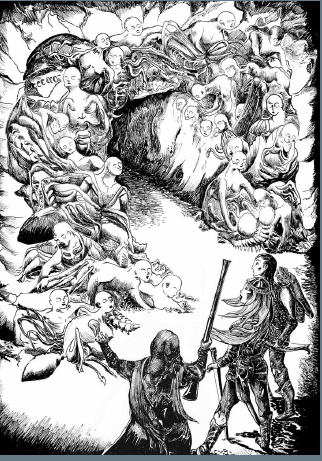
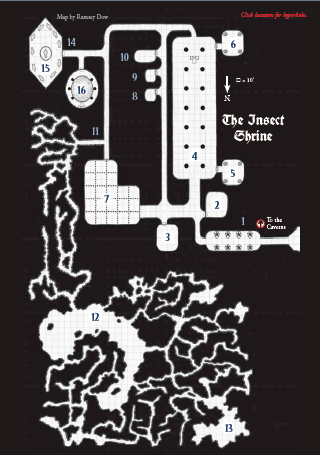
Eons ago this place was the central seat of power for the Insect God's worshipers. Now it's in ruins, inhabited only by monsters. It's lightly patrolled by Milizionäre, but none of them make residence in the area.
The random encounters here are less frequent (1 in 6 chance every 3 turns), and mostly consist of the insects from the caverns only in larger numbers. The Giant Wasps, thankfully, do not have a Save or Die poison (it just deals additional damage), and a few of the opponents are quite weak (Giant Moths and Giant Bees).
Aside from this, the Insect Shrine is even more perilous than the caverns. Right off the bat in Room 1 we have a Giant Stoneskin Cockroach, which only awakens if touched or searched. It can be avoided otherwise, but it's a 15 hit dice monstrosity with a 25 Armor. Effectively indestructible, although fortunately it has half the speed of a human (so the PCs can run away).
Where the Caverns had oodles of insects, a sphere-demon, and crazy bone-warriors, the Insect Shrine is more quiet, foreboding, subtle, and trap-heavy. The dungeons' insect inhabitants are usually dormant and attack only if disturbed, or are part of the dungeons' traps for greedy adventurers. I do like this shift, as it makes the dungeon feel less bustling with activity, yet dangerous enough to tell the PCs that the place is still watched over by foul forces.
The rooms, for the most part, are relatively mundane. Rooms 2 & 3 are storage spaces, a worship hall with giant wasp nests (4) at the tops of some gem-studded columns, two ritual cleansing rooms (5 & 6) inhabited by butterflies which fly into the characters' mouths to lay eggs (which will hatch into caterpillars weeks later and burst forth from their flesh), a sacrifice pen (room 7) with still-living giant earwigs and maggots in cages who will attack anybody who falls in (Raggi developed a rather complex system of determining balance for PCs in a sidebar), and three priest quarters (8, 9, & 10). The latter two have a jade caterpillar carving and golden scarab amulet, both of which are trapped. The caterpillar will eat the other items and money in a stored container before eventually climbing out to return to the room; the golden scarab will telepathically communicate with insects in Goblin Hill, tripling random encounter chances and will burrow into the flesh of a sleeping PC to eat its brain and give birth to mini-scarabs.
Sort of seeing a theme here; I get the whole Body Horror feel of insects inside your body, but this is like the third time at least I've seen it used in this adventure. The jade caterpillar, by contrast, is a very neat idea and still makes thematic sense will being original.
See that southern part of the map? That's one giant ant farm. Of giant ants. Now that the humanoid inhabitants are long-dead, the colony grew out of control and burrowed into the surrounding rock for room. There are 168 giant ants in total, but none will be hostile unless their Queen is attacked. The colony still has use for humans, and those who fall prey to them in the dungeon or surrounding countryside are taken here to be used as livestock:
quote:
This cavern is where the ants harvest the food that feeds both themselves and most of the insects, great and small, in the greater cave complex. Scattered across the floor of the main cavern are hundreds of human corpses, all covered in the fungus the insects use for food. Each corpse is more fertile when fresh—even more so when still alive! —but this fungus can grow on bones for centuries. When giant ants kill prey, or when soldiers paralyze their enemies, they are brought here, their arms and legs are amputated, and then the torso is intentionally infected with the fungus. Living cows will be fed to keep them alive as long as possible, as excrement is useful for food as well and when the body dies there will be a great feast as the fungus spreads throughout the organs and the fungal bloom which results really is something to behold.
There will be 1d6-4 such living cows among the herd here.
Dozens of giant ants and half a dozen soldiers (see #11) will be here working or guarding at any one time, but they consider this a neutral zone and will let intruders pass undisturbed to avoid threatening the herd. If intruders move, damage, or otherwise molest the herd, the ants will swarm to eliminate the intruders.
I honestly never would've thought to use insects this way. It's unconventional and creepy enough to throw the players for a loop, but plausible-sounding enough that suspension of disbelief is maintained.
The Queen lairs in room 13. Killing her will permanently Confuse (as the spell) the ant colony, but she's guarded by a legion of ants. The queen herself is immobile and can't attack, but has 13 hit dice and so will take a long time to kill.
Room 14's a puzzle door which must be unlocked to gain access to 15 and 16. It's a series of 4 handlesembedded inside insect statue mouths and a foot pad at the base. The handles all must be turned clockwise and the footpad pressed for the door to open. Skill checks are pretty much useless:
quote:
An Architecture roll will reveal that there are many levers and gears working within the door. A Tinkering roll will disable them… making the door impossible to open.
Given that Tinkering's the major Open Lock/Disable Device skill in LotFP, it's highly likely that many PCs will end up screwing themselves over. The Gem of the Insect is in Room 16 beyond, and the door's the only way through.
Room 15 is a mausoleum, inhabited by a Giant Zombie Praying Mantis who will attack anyone who opens the central tomb (they all have nothing of value). Like the Giant Stone Cockroach, the Mantis can make quick work of low-level PCs. Armor 19, 11 hit dice, 1 bite attack dealing 3d4 damage (the most of any monster so far) and 2 arms dealing 2d6 damage. It's slow as hell, though (1/4th human movement).
I get the feeling that PCs in this adventure are going to do a lot of running away from some very powerful monsters a lot of the time. Sort of in tune with LotFP, but the number's kind of pushing it.
Room 16 contains the only hope for our PCs to put a stop to the Insect God. The Gem of the Insect, a 4' tall magnificent ruby red statue of an ant, is at the bottom of the sand pit. An ant lion lives here. In ancient times cultists fed it living sacrifices, but it hibernated for much of the intervening thousands of years. If the PCs want the statue, they must kill the Ant Lion.
The Ant Lion is definitely a tough customer. It has 20 Armor, 8 hit die, and any attack it makes in the sand pit automatically pulls the target under, dealing 1d6 additional damage every round. To add insult to injury, the target must also Save vs. Paralysis or be paralyzed.
The statue is 75,000 silver pieces total, but it's easily broken into 3 segments worth 15,000 silver each.
That's it. If the PCs break the statue, the cult's plans have failed, the Insect God will sleep for eternity, and if the PCs played their cards right, they can entirely bypass much of the Caverns, the Bürgerfriedensmiliz Headquarters, and the Realm of the Insect God. The Mother hasn't found the statue yet, but it would be only a matter of time before her cult reclaimed the shrine.
Of course, if the PCs have Schwartz's time-traveling scroll, they can use it to transport themselves to the Shrine in its heyday. Raggi did not extensively detail the prehistoric world or the dungeon's past, but he does offer a few choice notes:
quote:
•The complex currently inhabited by the Bürgerfriedensmiliz would not yet have been built.
• The Mound would be an active facility.
• None of the towns and cities would be present on the map. The area would be much colder.
• The caves would be heavily trafficked by insects and cultists, but none of the odd encounters would be there.
• The cultists would all be three to three-and-a-half feet tall humanoids enjoying a higher level of technology and civilization than the Stone Age humans around them. They are evil halflings (what else did you expect, midgets?)
• The Insect Shrine would be fully inhabited and operational, but in the timeframe the spell would be in effect, most of the cultists are in location #16 performing a lengthy ritual.
• Location #7 would be full of victims; one hand and one foot removed, but the Referee should keep some guards around so the player characters can have duels atop the cages.
• A mass of cultists will be in location #16, with the great ruby ant statue on the altar. When the futuristic invaders are detected, priests will tip the ant into the sand pit where the ant lion will drag it below. There should be enough cultists in the way to prevent the player characters from stopping this.
• The cultists should be pushovers. 0 level, carry-only-daggers style pushovers. After all the rest of the crap to deal with in this adventure, it will do the players good to have ineffective, truly evil enemies to mow down. Keep the giant insects to a minimum.
To the bolded: the adventure earlier mentioned the prehistoric worshipers as Goblins. Now they're Haflings? And I honestly would've preferred them to be short humans; stock fantasy races don't feel right at all in Weird Renaissance Europe.
Thoughts so far: One of the better parts of the adventure. The atmosphere is perfect, and the giant monstrosities are slow enough for unencumbered PCs to flee from. This dungeon is overall more forgiving if the PCs are cautious.
Next time, the Bürgerfriedensmiliz Headquarters!
Goblin Hill - Bürgerfriedensmiliz Headquarters
Original SA post Better Than Any Man Dungeon 6: Goblin Hill-Bürgerfriedensmiliz Headquarters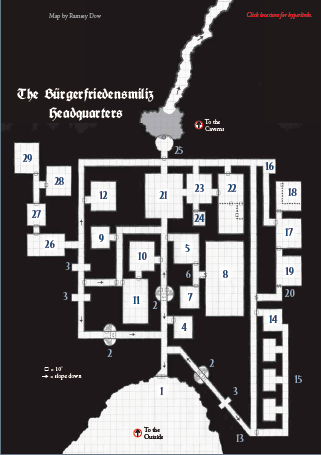
This armed compound serves multiple functions as a military fortress, "re-education center," and worship center for the Insect God. As mentioned in the Caverns, there is a secret entrance via the latrine. Otherwise the only direct route is through the front gates on the other side of Goblin Hill (room 1).
Several hundred milizionäre live here at this time. Excepting the few named NPCs, they're all 0 level humans with short swords and no armor. However, the barracks and armory have equipment suitable for soldiers. Unlike their counterparts in Karlstadt, most are trained in lethal combat and willing to kill to protect their fortress.
Going in the normal way is difficult. The front door (room 1) is continuously guarded by sentries, there are several murder holes (rooms 2) to shoot enemy intruders, and the hallways nearby are narrow choke-points and wire-framed alcoves (rooms 3) which can be blocked from passage via the raising of metal bars.
There's 29 rooms in total. I'm not going to cover all of them (quite a bit are mundane living quarters and storerooms), just the ones of particular interest and note.
Rooms 7 and 8 are the bedroom and workshop of the Engineer. Adeltraud Teschendorff is a mechanical genius and Insect God worshiper recruited by the Mother. The workshop is full of various clockwork devices, and given enough time she can don a clockwork suit of armor which is treated as an individual monster and has a Death Ray attack. Also aiding her are 3 automatons in combat.
quote:
The Automatons: Armor 22, 2 Hit Dice, Movement 30’, 1 bash attack doing 1d6 damage, Morale 12. Every hit against an automaton damages its functionality, giving it a -1 penalty to hit.
The Exo-Suit: Armor 20, 3 Hit Dice, Movement 30’, 1 bash attack doing 1d6 damage or 1 death ray attack (range 120’) doing 1d10 damage (can fire once every 10 rounds), Morale 12.
The Engineer: Armor 12, Level 0, Movement 120’, 1 dagger attack doing 1d4 damage, Morale 7.
Grossly high armor class for 4 opponents, but their hit dice is pretty low. Still feels pretty overkill to me.
The Engineer's inventions in progress are very advanced: land mines, a steam engine, and a sound recording machine (basically a record player). They have working notes and material, but will take time to make fully functional. None of them work correctly or as intended: the land mines are meant to be a timed explosion but explode immediately when primed, the steam engine just makes steam and will blow up if left on for too long, and the sound recording machine actually absorbs sound transmitted through the horn to be played back later. If the sound is played in reverse, it will Summon a random extraplanar monster.
The treasury, room 9, has only two guards, and has a shitload of treasure:
quote:
The followers of the Insect God are preparing to rule, and rulership requires funds. This room contains 25 chests, each
containing 1d100x10sp. Two milizionäre with whistles guard
the door, which is kept locked.
Now that's a lot of potential treasure. Keep in mind that in LotFP, thereare no Bags of Holding or extradimensional safe spaces, and no market for magic items. However, LotFP uses the "treasure as experience" rule, on a 1 silver piece for 1 experience point basis once the PCs get back to civilization and spend/save their loot (it's expected that players will gain most of their experience this way). To get to 4th level, a total of 6,000-9,000 experience (depending upon class) is required. On average the combined lot should net 6,750 silver divided by the PCs present.
I just realized that there are several opportunities for PCs to level up quickly. The ruby ant statue alone should be enough to push PCs past Level 4.
Rooms 13-15 are the barracks. Most milizionäre here are unarmed noncombatants, such as children and their caretakers. The rooms, even those for the elite, are spartan and designed completely for functionality, in line with the Insect God’s aims:
quote:
The ultimate goal that the Insect God has for humanity is to wipe out the vast majority of them, leaving a scant few to perform various tasks that insects are unable to, and to be breeding stock for food. Towards that end humanity must be domesticated and conditioned to suppress individuality and ambition. The living conditions of the average Insect God worshipper reflects this goal, even if most of the time the average worshipper does not seem any different than the average person.
These barracks are spartanly furnished and absolutely packed tight. Each room contains sleeping areas for 100 people (men, women, and children are not separated) in beds stacked three high.
Note that even though masses of men and women live together, and there are children, sexual desire is being suppressed through various means of conditioning and this has been so successful that The Voice leads breeding exercises twice a month (in the dining hall) to promote reproduction, and no one looks forward to them. For now, only those old enough to be considered of a socially acceptable breeding age in the outside world is made to attend, but the eventual goal is to start breeding at puberty once pretense and secret co-existence with the outside world has been abandoned.
Kind of makes me wonder how many of the cultists are aware of their future fate. On a related note, I haven’t found any in-character incentive for the Mother and her cult on what they gain out of servitude. Guess it’s just meant to be a flat villain in the “evil cthulhoid cult” vein. I can get behind that ordinarily, but it feels odd considering that the motivations and backstories for the other power players (the Seven, the Prince-Bishop) are more understandable and nuanced.
Rooms 17-19 are the domain of the Voice. Not one of the Seven, Ottilie Trautvetter is an alchemist from Hamburg and drifter who tried to rob the Mother while in Karlstadt. In an attempt to intimidate her, the Mother let slip that she was a devotee to the Insect God, and Ottilie convinced her that she was one of the faithful. Now she performs various experiments for the cult, from alchemy to crossbreeding monstrous insects with animals. She is a 0 level human with a giant bee stinger as a weapon.
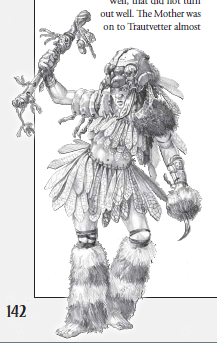
Room 18's the Birthing Chamber, and the Voice is in the middle of breeding Giant Horseflies with horses to make the perfect mounts for the cult. She has an alchemical mixture which can induce cross-species fertility, and has been successful. A horse gave birth to 5 hybrids, which have eaten their mother. They'll attack the PCs and try to escape; if successful, they'll breed outside and spread their numbers over the years.
Room 19 is her private chamber. In addition to roasted human flesh (she's a cannibal, too!) and a small Insect God altar, there are 5 trapped chests with loot. One of the more interesting treasures is a set of books:
quote:
Chest #1: The trap is an electric current that surges through the inner frame of the chest. Any metal object stuck in the keyhole or smashing the chest will trigger the trap. The person holding the item will take 2d6 points of damage, half if he saves versus Breath Weapon. Inside the chest is a metal jar full of fireflies (supplying the charge!), and a sack full of books. The books are scholarly works written in Arabic about the strengthening effects of eating human flesh. The books will take 5d4 days of uninterrupted reading to finish, and the end result is that the reader will believe they have the information to gain ability score bonuses after consuming a diet of flesh for at least ten straight days. If anybody actually follows this course of action, bad news, it will not actually do anything. Just because it is written in Arabic does not mean that the author is not crazy.
quote:
Chest #3: The trap is a rust-causing gas contained in an empty compartment in the top of the chest. The ruddy brown gas will fill up the room and every metal item will corrode and become useless (not the insides of the chests as they are airtight), and human flesh will turn a bright cherry red for 24 hours. Inside this chest is a small totem of the Insect God made of wicker, tin, and dried offal. It is worthless to anyone other than disciples of the Insect God
I guess we can add "trolling the PCs" to Save or Dies and uber-powerful monsters for avenues of player aggravation.
There's also rules for mixing chemical ingredients in the Voice's workshop (room 17), in case the PCs want to mess around with her research. The Voice has been using stone shards from a meteor in her alchemy, which bestows an additional effect on the right-hand table.
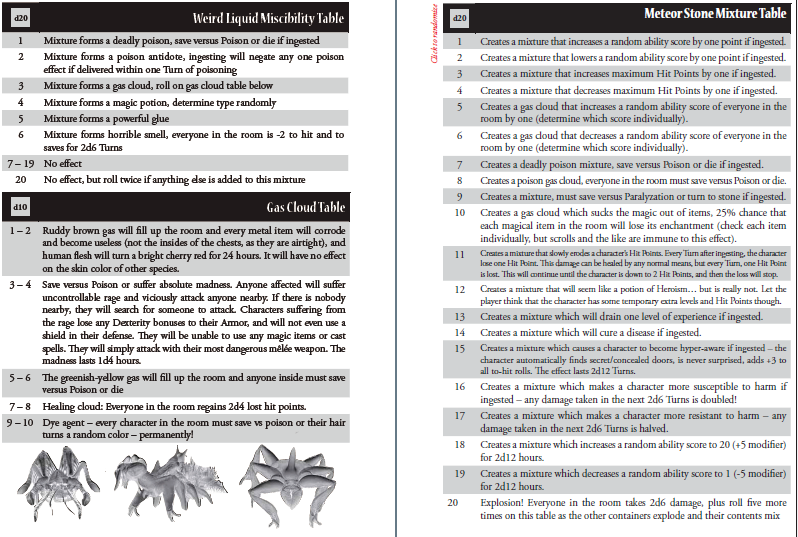
As you can tell, the negatives outweigh the positives, but Raggi notes that if anyone complains, tell them that messing around in a cultist's laboratory isn't something they should do in the future. Sometimes I wonder if he's one of those Killer DMs...
Room 23 is the kitchen:
quote:
There will always be half a dozen chefs here going about their work, and often several others, including children,) looking for scraps and treats.
The kitchen’s primary output is human meat, and the staff do their best when supplied with fresh livestock, both “pre-processed” in the torture chamber and raw specimens—each is used for different dishes, although they do realize the importance of fruits and vegetables and grains. As a result, this place does not so much resemble a kitchen as it does a slaughterhouse and barbeque pit. Thus the kitchen is the one place where the Insect God’s followers’ threat to human life and stability is on clear display.
The illustration on the next spread is just an example of what goes on here. The Referee should push hard to create a gross, cruel-spirited description of the place. There’s no “sanity mechanic” in LotFP; it is up to the Referee to blur the lines for the players at the table between “I’m your friend presenting this fictional situation” and “I’m getting a little too into this description, is everyone’s skin crawling yet? No? We’ll let me tell them about what’s going on with eyeballs…”
Rafael Chandler (of Scorn: The First Book of Pandemonium and Teratic Tome fame) suggests: “ Suffering is most intense (to the audience) when the victim is singular and humanized and trying to avoid the pain. So the Referee might start to describe such scenes by noting the actions/words/plight of a single victim before zooming out (so to speak) to address the tableau in its entirety.”
It is here where the Insect God’s worshippers stop being generic fantasy threats and start being the truly despicable villains needing to be wiped out that they are.
The accompanying image is a full-page illustration of the kitchen; dead naked human bodies, including one baby corpse, are hanging from the ceiling. Two people pull entrails out of the adult bodies as children hold their hands out under them to catch the blood as though to eat it. A dead woman is rotated on a burning spit roast while cultists haul dismembered limbs to a giant stew pot.
This is one of those times I feel that Raggis is trying too hard. I get the whole cannibalism thing, but it's just thrown in there with no prior explanation. The whole thing is obvious shock value.
The last four chambers (26-29) are the Mother's quarters. 26 is the throne room, where she will make a last stand if the complex is invaded; 27 is the guard chamber, where her servitor creature usually is; 28 holds the Telling Mirror, a magic item which will answer any question posed to it so long as it's specific and begun with "mirror, mirror, on the wall." 29 is her personal bedchambers, containing her personal funds and the Maker's spellbook along with her head on a silver platter.
The Mother's room is actually located over an open space in the caverns, which lead down into the Realm of the Insect God. The spirits of those who perished below haunt her dreams, encouraging her to expand her power. The spirits want someone to set them free by digging into the earth, but she's crazy and misinterprets their messages to "invade outward" instead of inward. Nobody in the Insect God cult knows of this cave or its connection to their deity's realm.
If there is no combat, the spirits will speak to a single PC, begging them to set them free and to dig below the earth. It will take several hours of digging for several humans to make their way to the underground passage, which is Room 1 of the Realm of the Insect God.
Thoughts so far: A heavily-defended complex, this is the cult's center of power. The PCs could take out the Mother, and the Swedish Army will kill everyone within the headquarters on days 9-11, but unless the ruby ant statue is found and broken, the Insect God will still be around and can contact others.
Next time, the Grand Finale, the Realm of the Insect God!
Goblin Hill - Realm of the Insect God
Original SA postAlien Rope Burn posted:
I have to wonder what's in it for adventurers to be adventurers in Raggi's... adventures. Idiocy? Masochism? Suicide pacts?
It's implied that in the world of LotFP that nobody really wants to be an adventurer. Clerics are instructed by their church/entity/etc to go out and destroy aberrations, Magic-Users are villified and driven to the fringes of civilization, Fighters are the only true warriors who can slay fell beasts and did a bunch of terrible stuff in the war which makes people feel uneasy around them. Specialists (or 'thieves' in other OSR games) adventure for a living, and the other classes regard them as crazy.
The worlds of LotFP are prettty crappy, tiny pockets of civilization in a sea of monstrous wilderness and eldritch places. And even the places of civilization are tyrannical and insulated places, and PCs are pretty much social outcasts who for one reason or another can't get along with contemporary society.
Alien Rope Burn posted:
In any case, I'm not terribly convinced that the cultists of the Insect God "stop being generic fantasy threats". Worshippers of a god trying to take control of his world with itsdemonicinsect minions? Yeah, really breaking that mold.
It's disappointing because the "villains" start out feeling rather nuanced and then it seems to really focus laser-like on this apocalypse cult, which doesn't have much to do with the plot save to offer up dungeons, as far as I can tell. Smart PCs would just wait for the army to march through and then clean that shit up afterwards... but I guess you don't earn as much XP that way.
Ah, but the Swedes will either collapse the dungeons so that nobody can find it, or they loot much of the treasure. Meaning that the adventure ends once the Swedes finish their massacre.
And the dungeons are a large part of the adventure, in terms of page count and loot/XP. The rest of the plot is just a background. Except for the Seven, who are tangentially connected to the Cult of the Insect God anyway. I think that this is some missing potential. Only 1 of the Seven, the Mother, knows of the cult's true workings, and the adventure does not explore what the witches would do if they too discover its existence. Some of them could make for unlikely allies, such as the Defiler and the Watcher.
Anyway, the final part of the review!
Better Than Any Man Dungeon 7: Goblin Hill-Realm of the Insect God
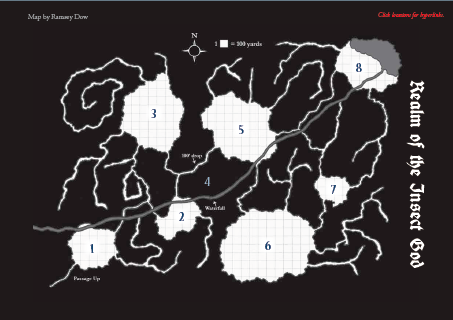
While still on the mortal plane, this cavern is the domain of a deity. It's been cut off from the outside world for millennia.
quote:
If camping or resting to regain spells within this cavern system, Clerics will be directly contacted by their deity, telling them to “Leave this damned place at once!” No spells will be granted, as this is the domain of another Power. Any time a divination or any informative spell (Detects, etc.) is cast by anyone, instead of the normal effect the spell summons 3d6 spirits of humans being devoured by ghostly insects. The spirits will appear for 2d10 rounds, screaming all the while. Every so often, one of the spirits will see through the veil of death and warn the adventurers to run while they still have their souls
The warnings are more than just a "here is a dangerous dungeon for PCs to explore!" It really is that lethal. There is no priceless treasures or loot to be obtained here and entering this complex is entirely optional as far as solving Franconia's troubles. If anything fully exploring this complex is actually detrimental to the PCs' goals, for reasons discussed later.
Mundane insects are all over the place, so much that stepping anywhere will kill dozens of them and even opening one's mouth uncovered causes it to be filled to the brim with flying bugs. The only random encounters are 1d6 bugs with 1d6 hit dice, with 12+1d6 Armor and an attack dealing 1d6 damage per 2 hit dice.
Room 1's a cavern with a canoe and four skeletons. The corpses date from the Bronze Age, and the carvings on the walls are scripts from this era. A river (the blue line on the map) travels through much of the cavern, and can be traversed with the boat provided.
Room 2's another cavern inhabited by a tribe of 50 cockroach men. They will attack anyone not traveling on the water. They're very tough for PCs to fight (8 hit dice but attack as 2 hit dice creatures, 18 Armor, bite attack which inflicts random disease).
Room 3's illuminated by a film of material which looks like the Northern Lights (aurora borealis). The light covers every surface, and a giant insect on the cavern's top appears trapped, yearning to break free. If the PCs are foolish enough to break the film, it will form into a giant insect filling up the whole cavern. It's so huge it's attacks count as area attacks and can attack 4 times a round. It is immune to non-magical weapons (none of which the PCs would've found in the adventure), has 21 Armor, 20 hit dice, and can kill itself in a suicide flash attack which blinds people for 2d4 days on a failed save.
Very TPK-worthy, but the PCs have nobody but themselves to blame if they mess around here. Plus the insect can't exit the cavern.
Room 4 is a 500 foot waterfall in the underground stream, which can be climbed down on its sides easily enough if Unencumbered. Traveling via boat moves too fast for the PCs to react. Falling damage is the same as in 3rd Edition (1d6 per 10 feet, maximum 20d6). Another potential TPK.
Room 5 is an unstable section of the dungeon, held up by a giant obsidian ant statue with legs spread out across the cavern. Pieces of the ceiling fall at irregular intervals every so often. If the statue is touched in any way, it will break and bury the PCs under tons of rock.
TPK Count in this dungeon alone: 3.
Room 6 is covered in a brown sticky liquid which falls from the ceiling like rain. It's actually the reformed hemolymph of every insect killed in the world, and drains through the countless cracks in the cavern floor to exit elsewhere and be reborn as new insects. The spirits of trillions of insects live in this cave, and the room has a trap for spellcasters:
quote:
Nevertheless, if any divination or information spells are cast, or if a Cleric attempts to regain his spells after resting here, the intended spell effect does not take place (and/or no spells are granted), and the offender will be overcome by the spirits of ordinary insects invading his psyche. The character must make a saving throw versus Magic, and if successful, he will merely have the mind of some random insect for 2d12 hours. If the save is failed, his mind will have been completely wiped out and replaced (not changed) by that of a mundane insect.
Not a TPK, but a very situational Save or Die. The former scenario is far more likely, as I can't imagine any halfway intelligent party resting in a cavern entirely filled with bug blood.
Room 7's the domain of a 100 foot tall giant, buried up to its neck in earth. Most of its body and brain is infested with insects, and as such its mind has deteriorated into barely sentient insanity.
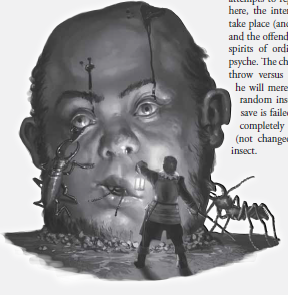
quote:
The giant has been here for millennia, a captive of the Insect God who thinks it is the god and master of humanity in the same way that the Insect God is the god and master of insects. The giant is the largest and most powerful example of its order, and thus must be the spiritual, mental, and physical leader of its kind. The Insect God therefore believes in its its absolute supremacy over the God of Man, and in each of its children as better than any man.
That's where the adventure gets its name! Unfortunately the giant can't communicate, so there's no real way for the PCs to find this out.
Room 8 is the Lair of the Insect God.
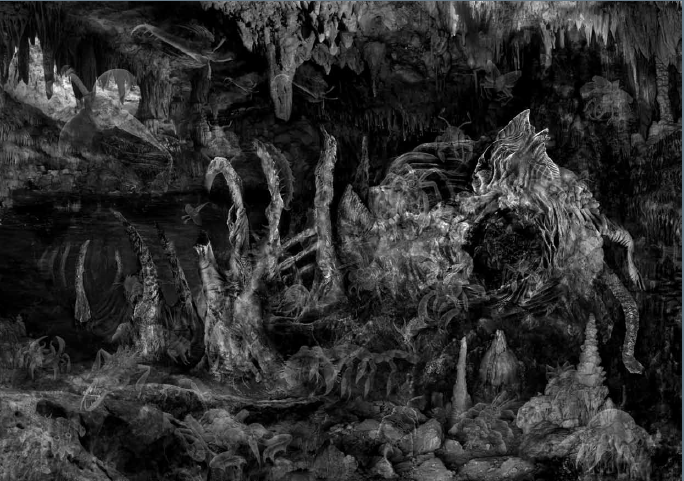
The carcass of a humongous caterpillar edges out from the pond, its visible body over a hundred feet long (and far larger below the water). Insect colonies and intelligent slimes and oozes have hollowed out most of the creature and live within and around it.
Even though the Insect God is missing most of its body and brain, it is still supremely powerful and intelligent, and will immediately establish contact with the PCs.
quote:
The hum will coalesce in the intruders’ minds as a very low-pitched, calm voice. “I have been… waiting…for… you. You
will die… and serve me.” At this point, materializing out of the ambient light, will be the phosphorescent ghosts of monstrous giant insects, with wings and clawed limbs and stinging tails and horrible mandibles.
There are thousands of them, and they will attack everyone present except the most powerful warrior – this one they will ignore. As each party member falls, whether from damage or strength drain, they will transform into a horrid, insectoid abomination like the rest. These things cannot be Turned—they are in the very presence of their god!—and will pursue their prey anywhere within this cavern system.
Once everyone else is transformed, the strongest warrior will then be grappled by the lot of them. This will not drain his strength. He will then be brought before the giant rotting mass.
A dozen insectoids will then sting their captive, laying hundreds of eggs which momentarily hatch. As these creatures deliver incredible agony as they skitter throughout the interior of the warrior’s body (this allows the Insect God to know everything the victim knows, from any distance, even across planes), another insect creature delivers a strange blade made of chitin.
The telepathic voice speaks again. “You will be my servant on the surface world. You will slay all two-legged defilers of planet Earth and claim their souls in my name. You will teach the world to fear me, to worship me, once again. And thus I shall be made whole as at the dawn of time. Go now, my eternal slave.”
With this, the character will be released with the new weapon in his hand, the ghostly insects will fade back into the light, which will itself presently fade, and the dead gargantuan god will once again be silent. The character is now alone, in the dark, but free to go.
Potential TPKs for this dungeon: 5.
The insect ghosts are relatively weak, but they're practically infinite and can't be harmed by physical attacks. The Insect God, on the other hand, is unkillable.
quote:
Insect God: Armor 29, 75 Hit Dice, Movement 0, only takes damage from attacks if the damage roll is 9 or greater, no physical attacks, immune to any mind-affecting spells and poison. Can telepathically communicate with any creature within five miles and read their minds. Can mentally communicate with and control any 6-limbed creature within 220,000 miles. Fails saving throws only on a 1.
The chitin sword given to the last surviving PC grants a +5 bonus on to-hit rolls, sends the souls of defeated opponents to be consumed by the Insect God, and cannot be rid of without a Remove Curse spell. The PC will become murderous, attacking any non-insect or arachnid on a failed save who refuses to convert to the Insect God's worship on the spot. Over the period of ten weeks it will transform the wielder into an upright insect, granting a +1 natural bonus to Armor per week.
There is nothing good to be gained for the PCs to explore this place. If they want to stop the Insect God's awakening, they'd do better destroying the ruby ant statue in the Insect Shrine. And if they want to save Würzburg from the Swedish, they'd kill the Mother in the Headquarters and the rest of the Seven in Karlstadt.
Final Thoughts: I'll start with the good. This adventure is definitely engaging, full of interesting plots and characters, the locales, monsters, and additional items and magic are very creative and unlike many other products out there. James Raggi put a lot of time and effort into making this adventure, and it shows.
And now for the bad. The adventure is way too lethal in way too many places, the randomness of several encounters makes it hard for the DM to plan risk assessment, and a lot of background stuff will be passed over and unknown to the PCs. I also feel that Raggi tries too hard to push the envelope in some areas.
Overall, this adventure is worth it for mining ideas. If you like it, then you'll like Lamentations of the Flame Princess and its extended line of products.